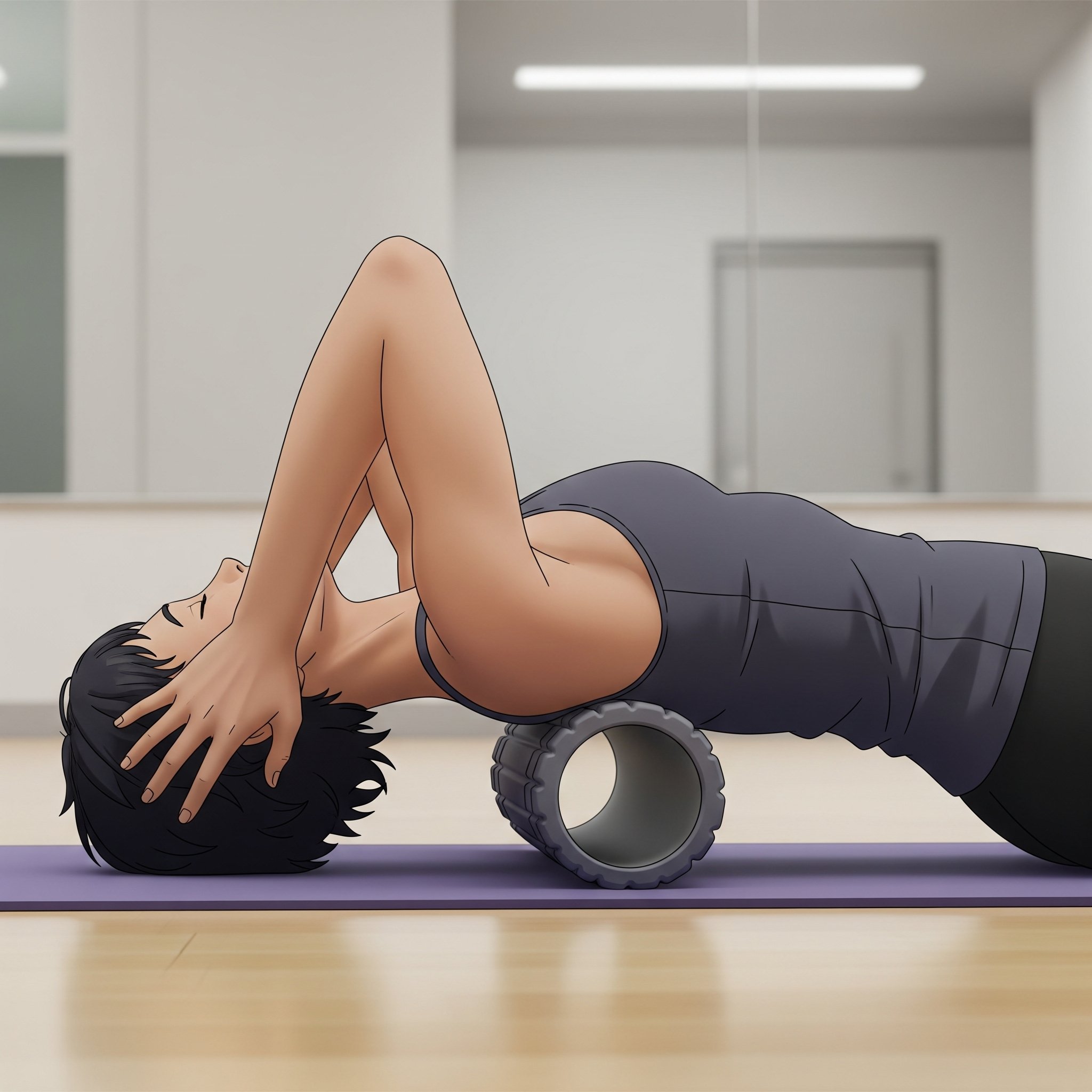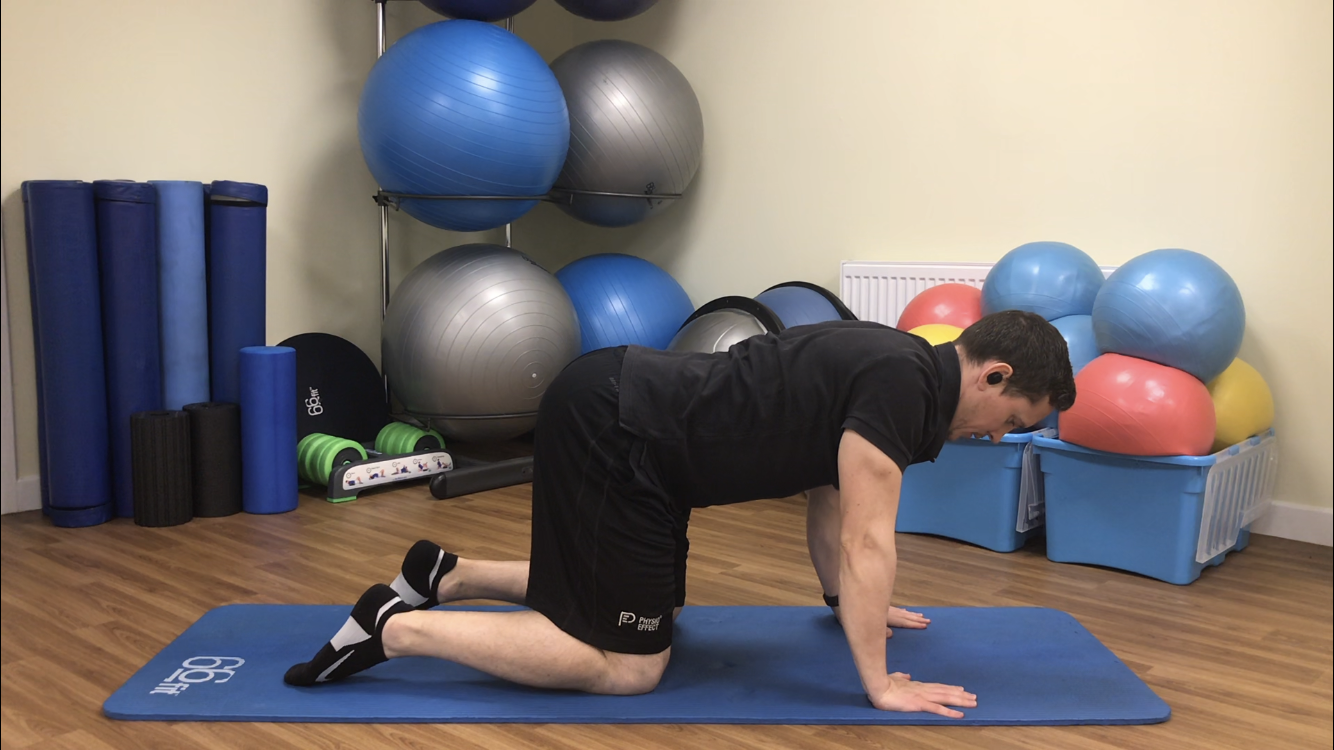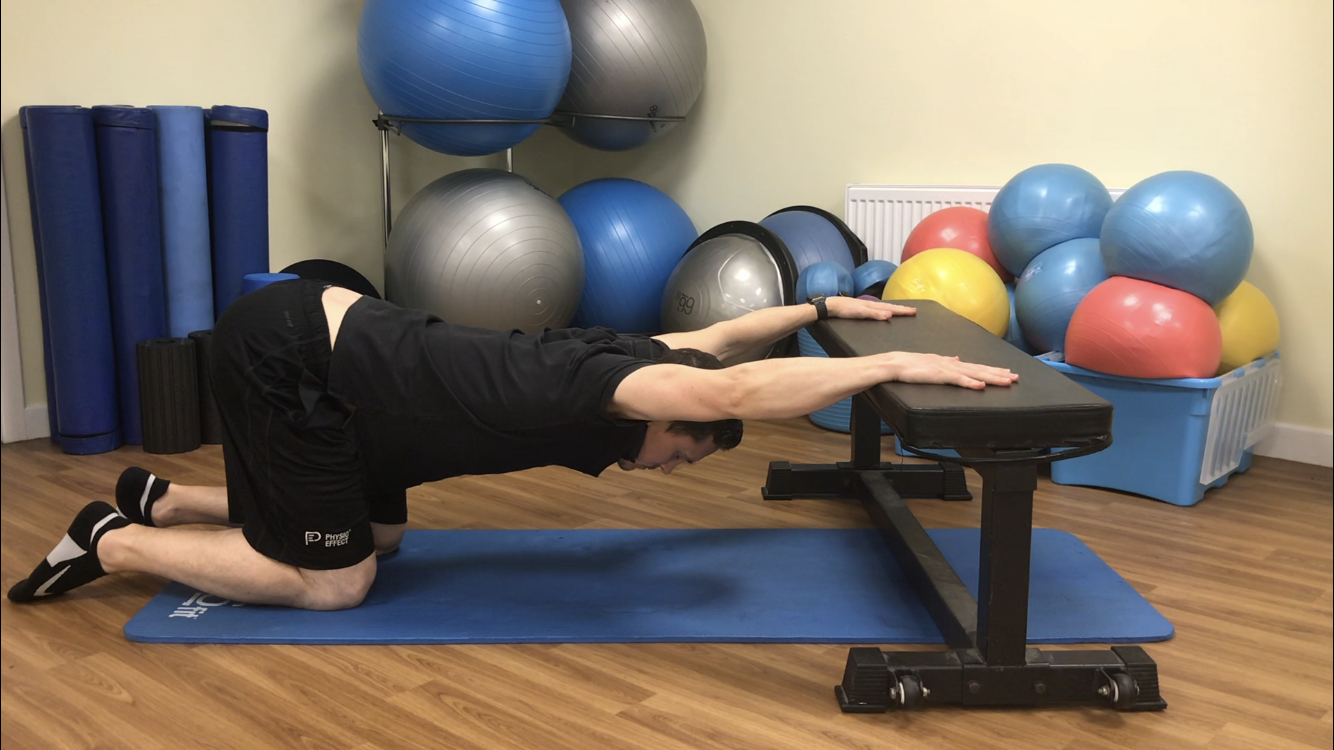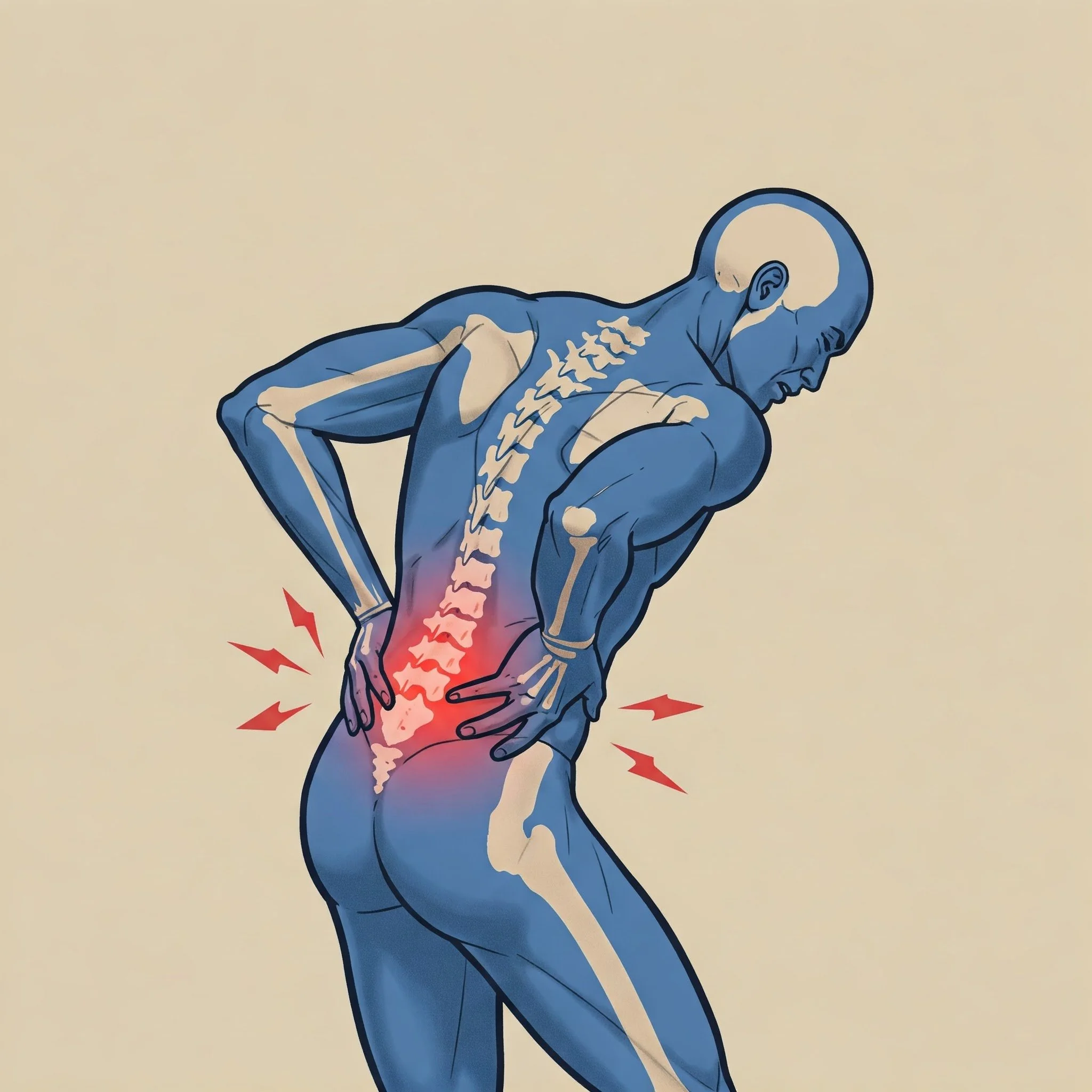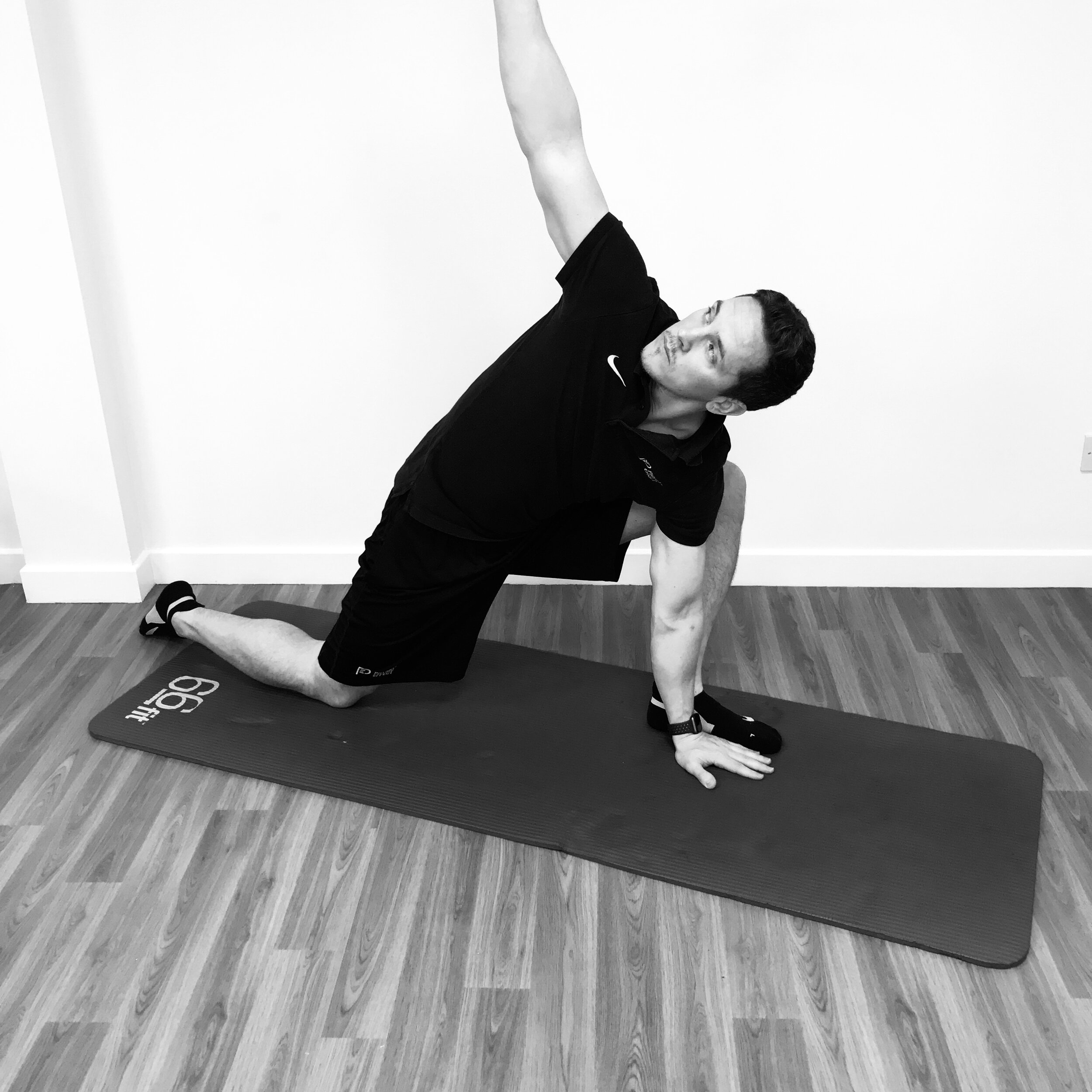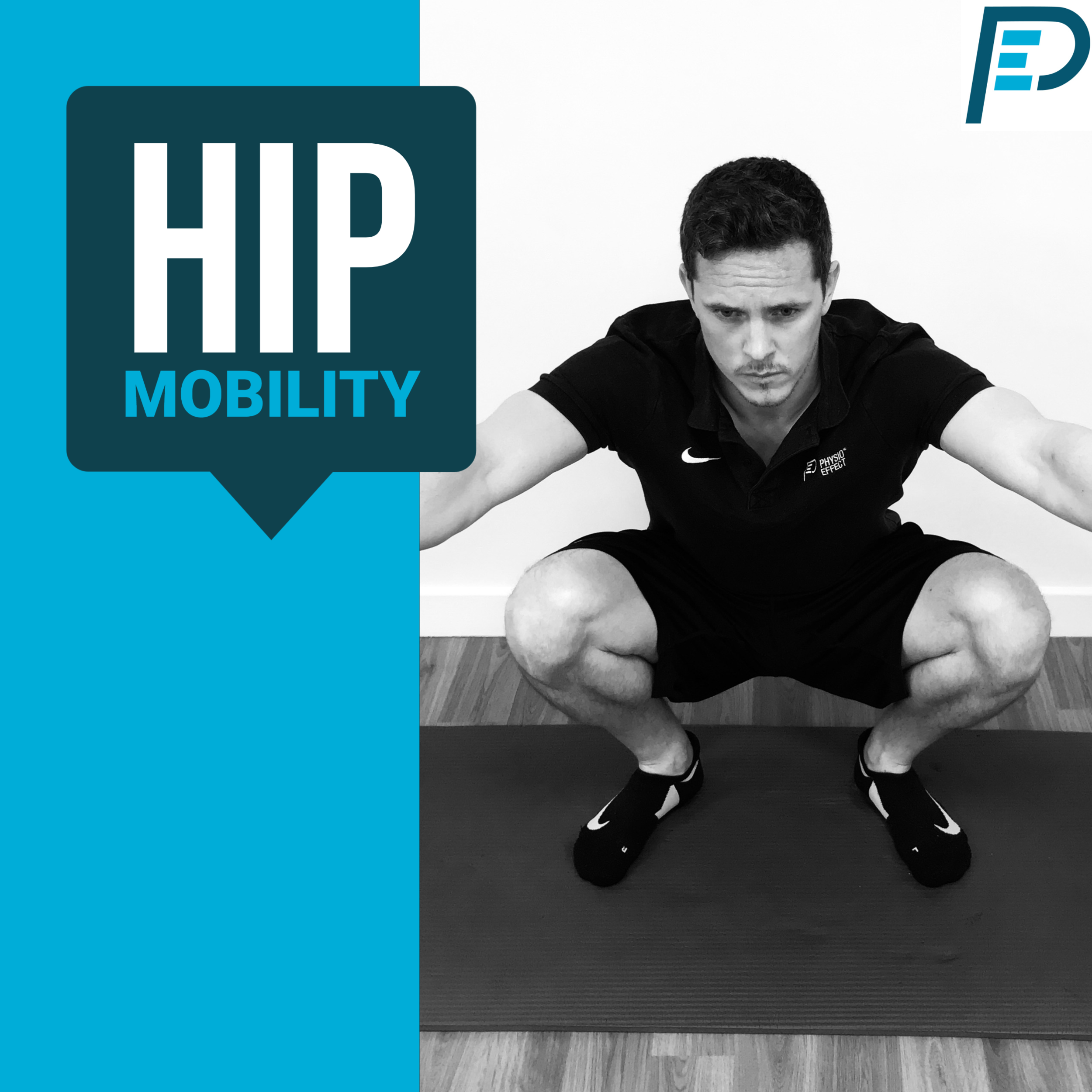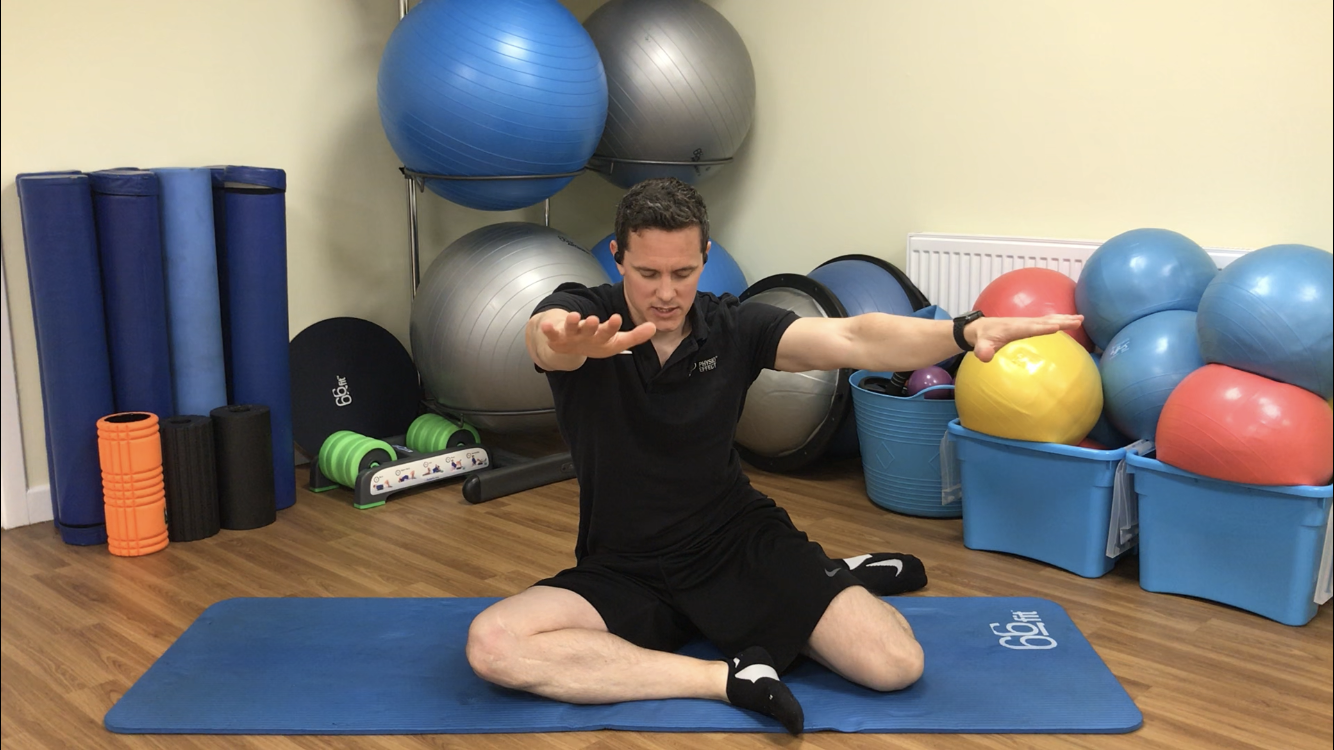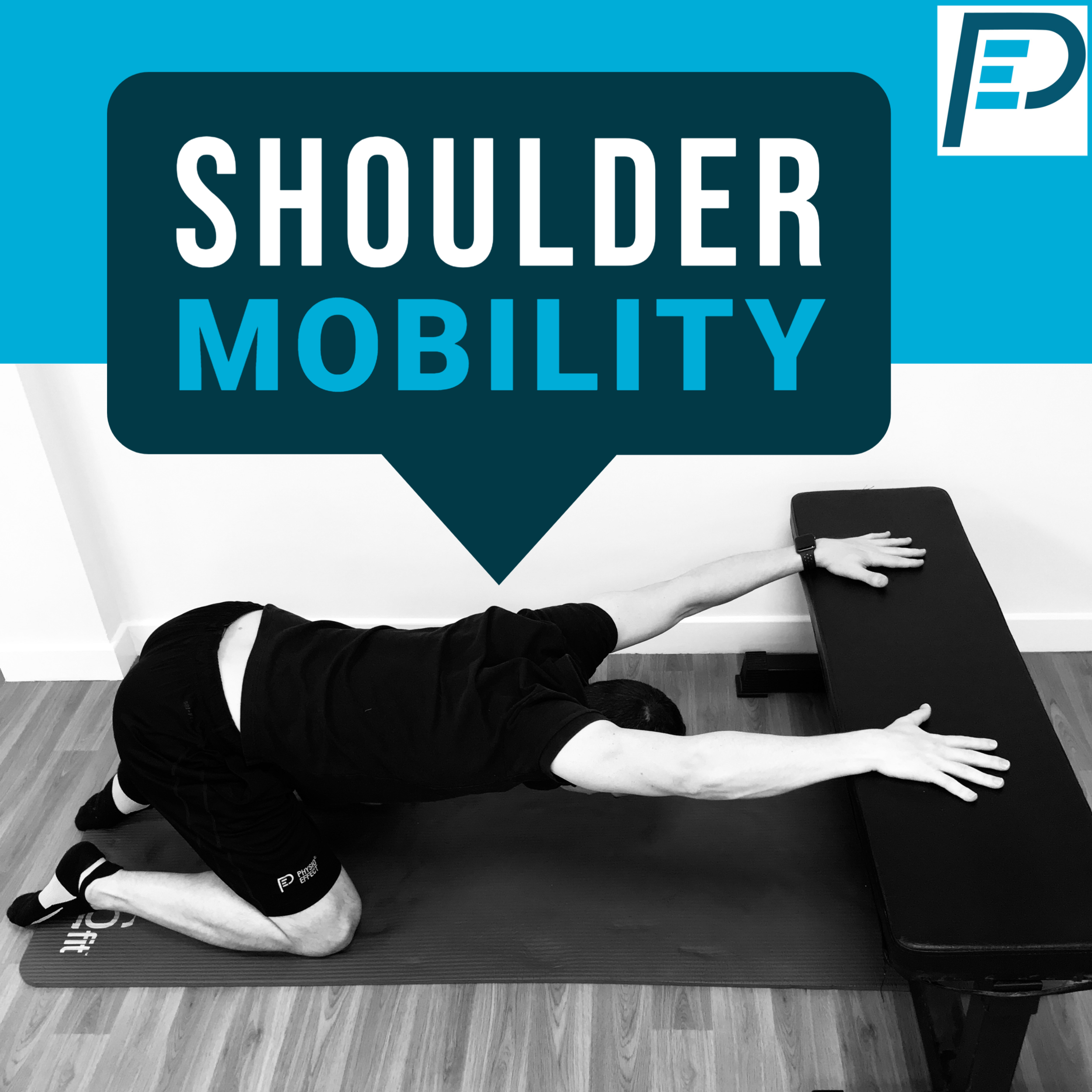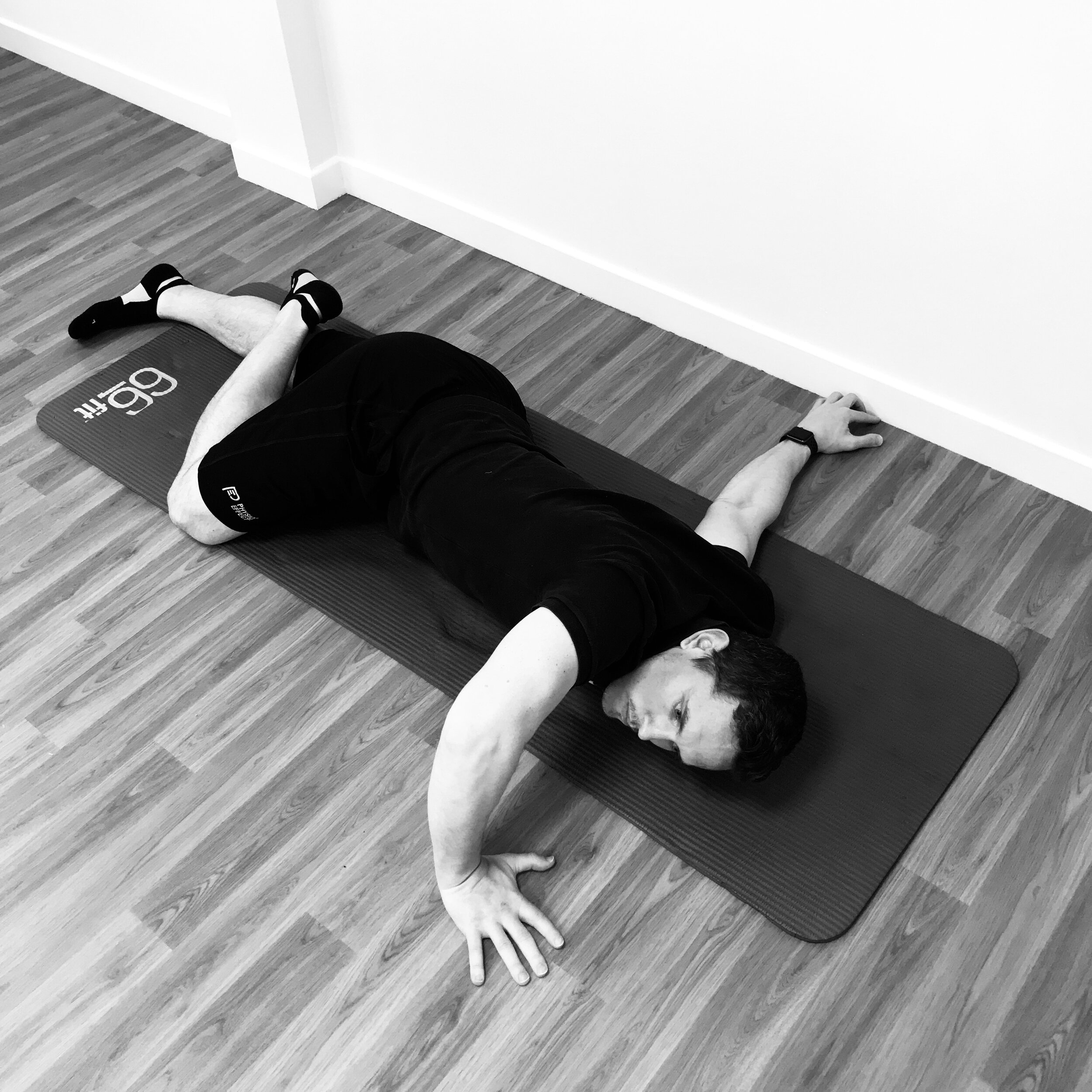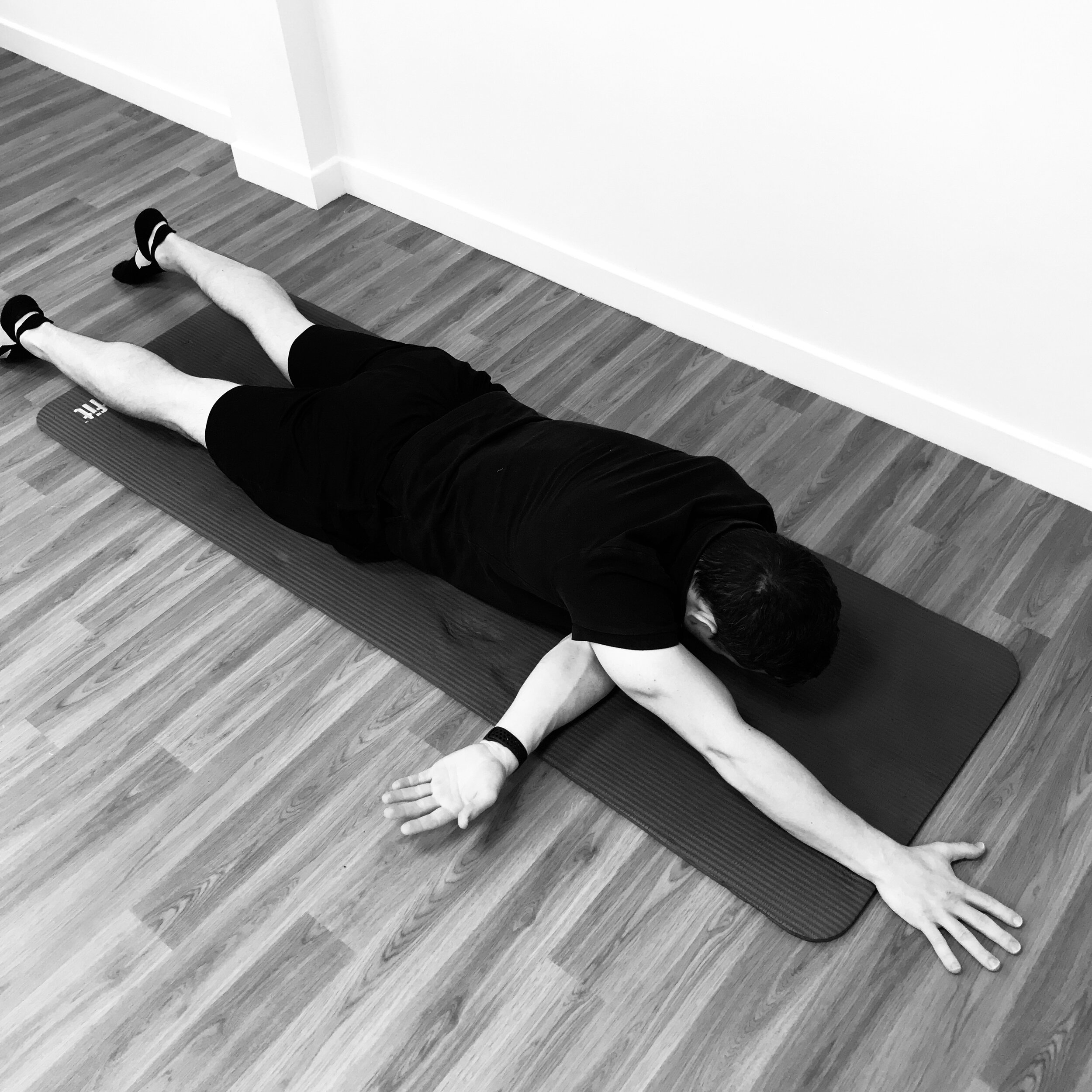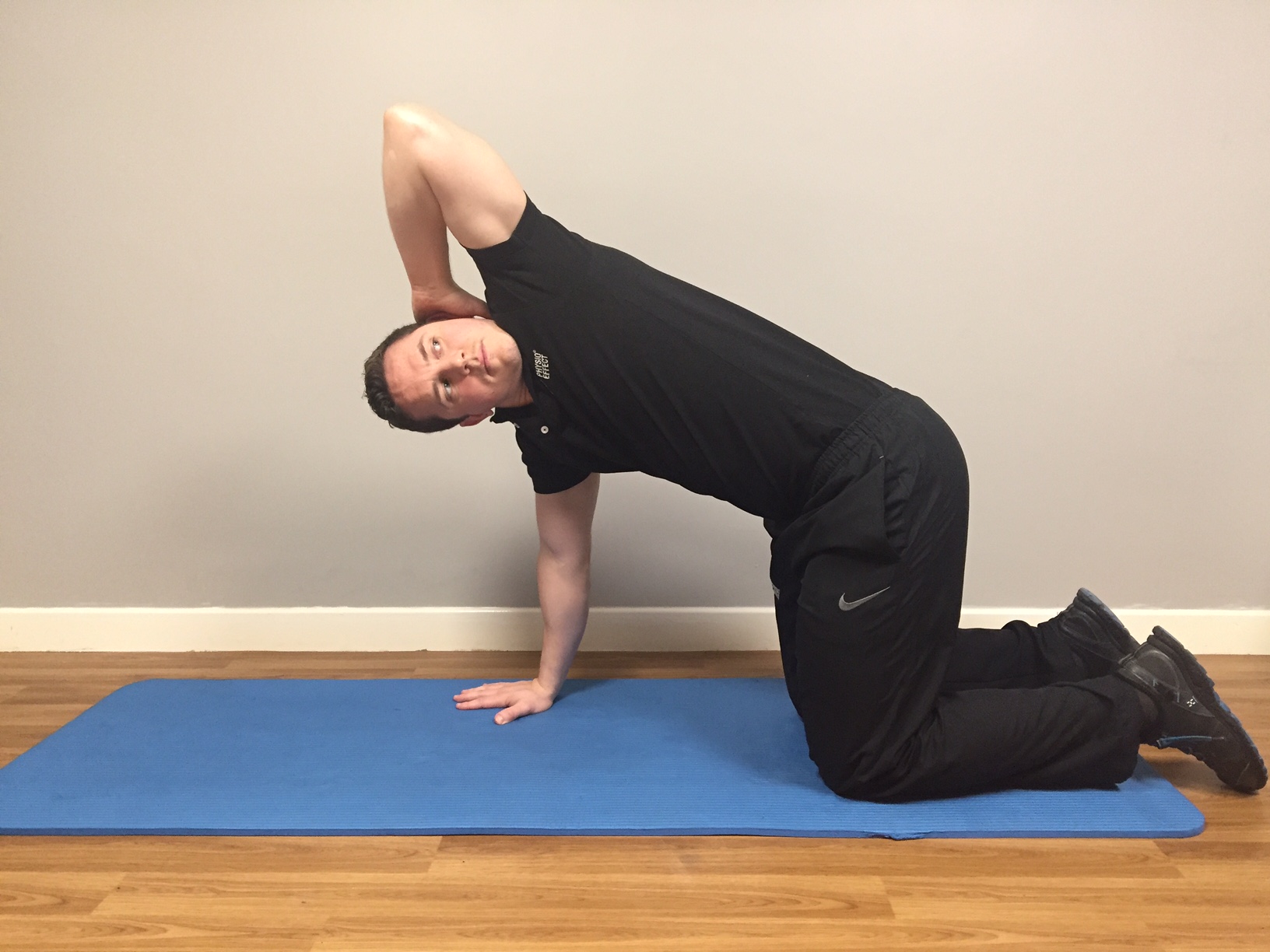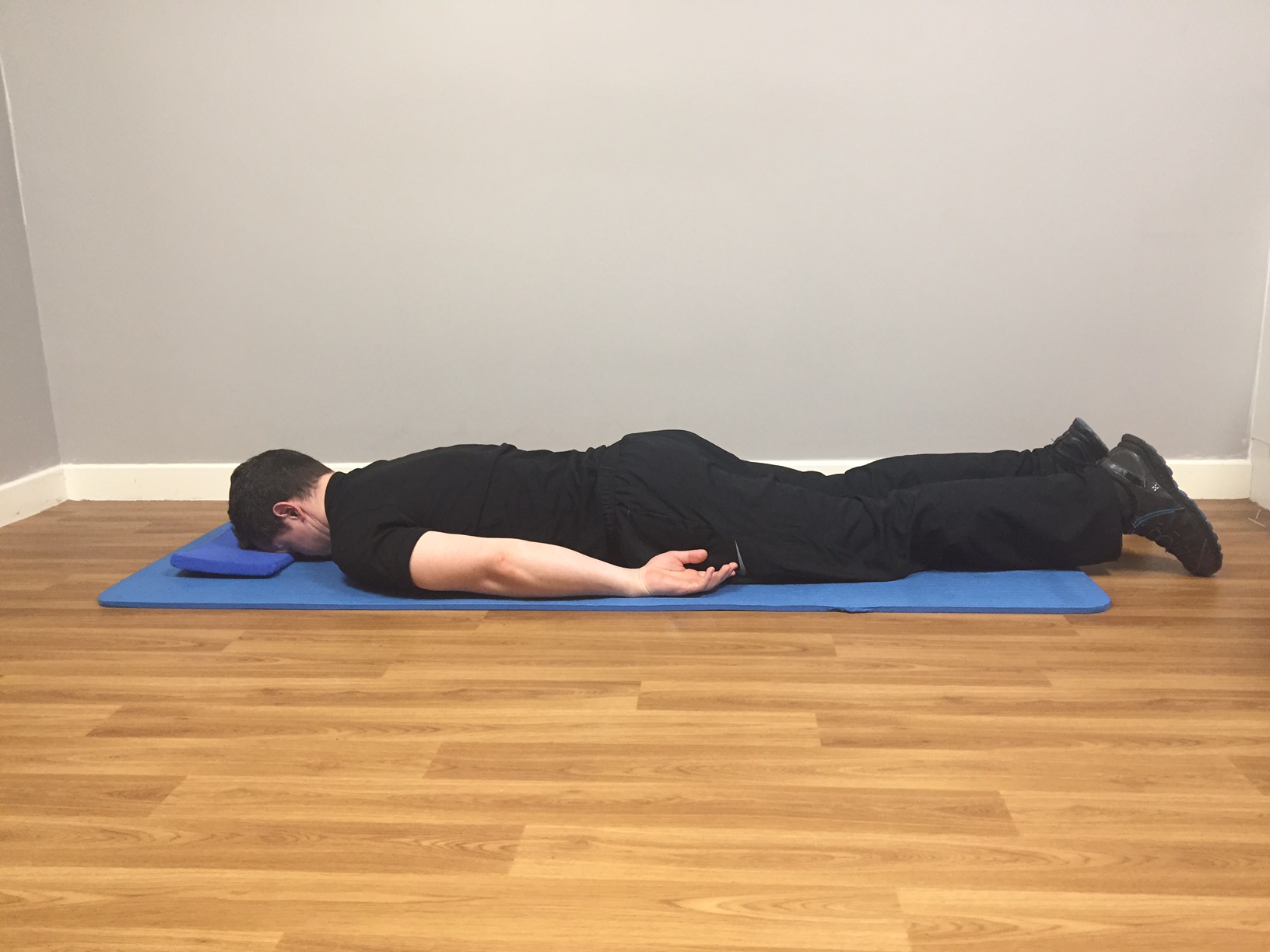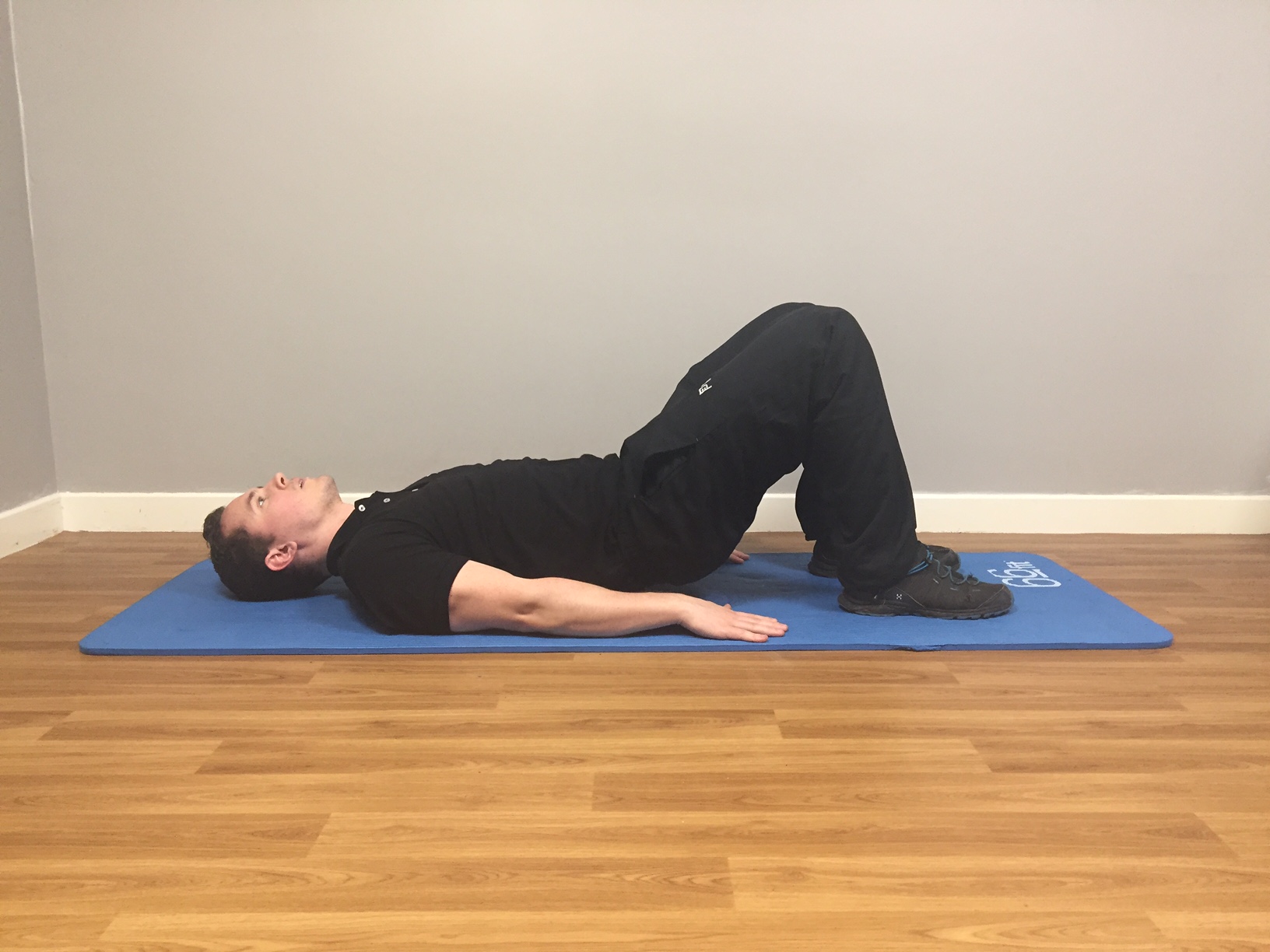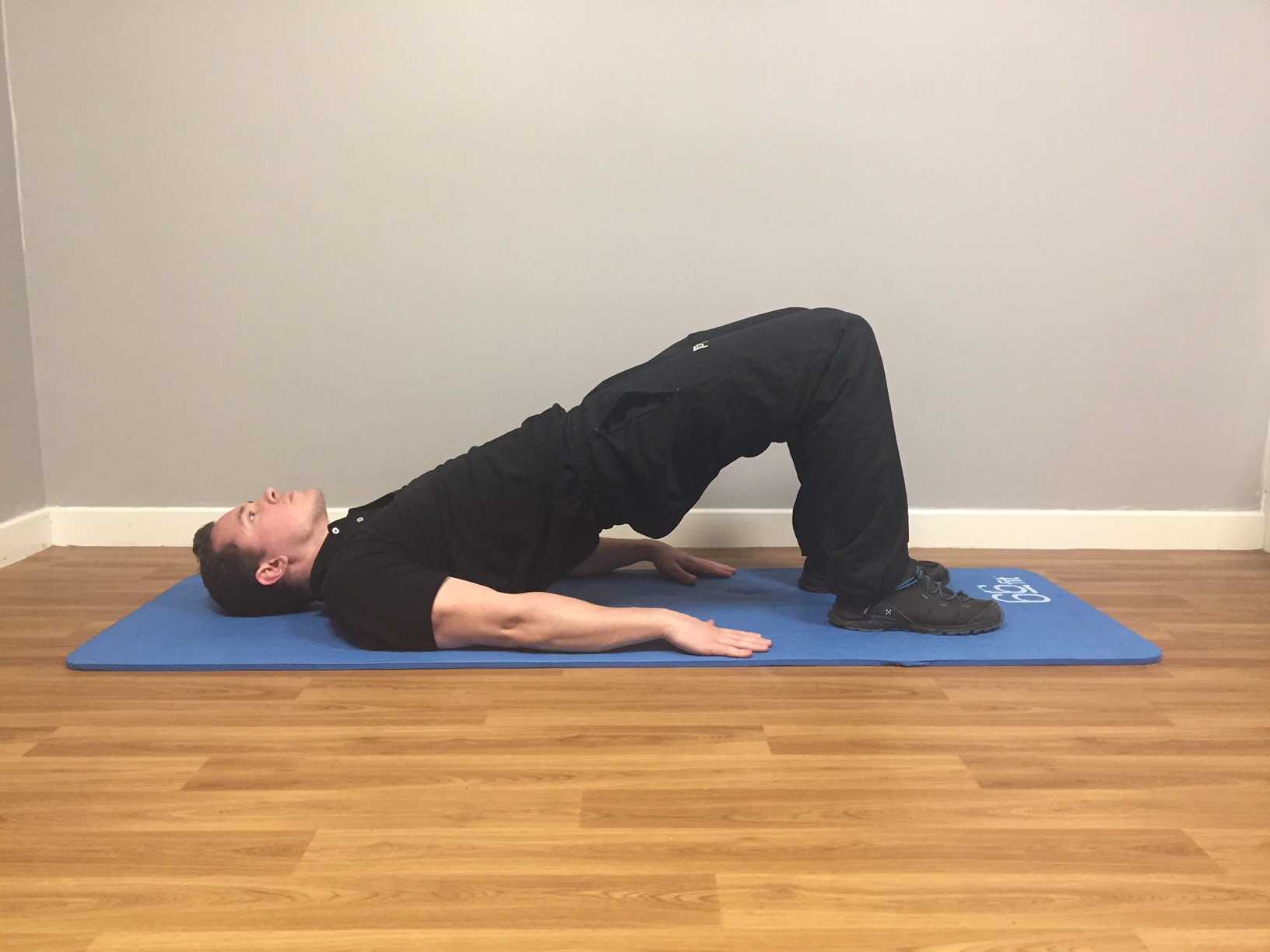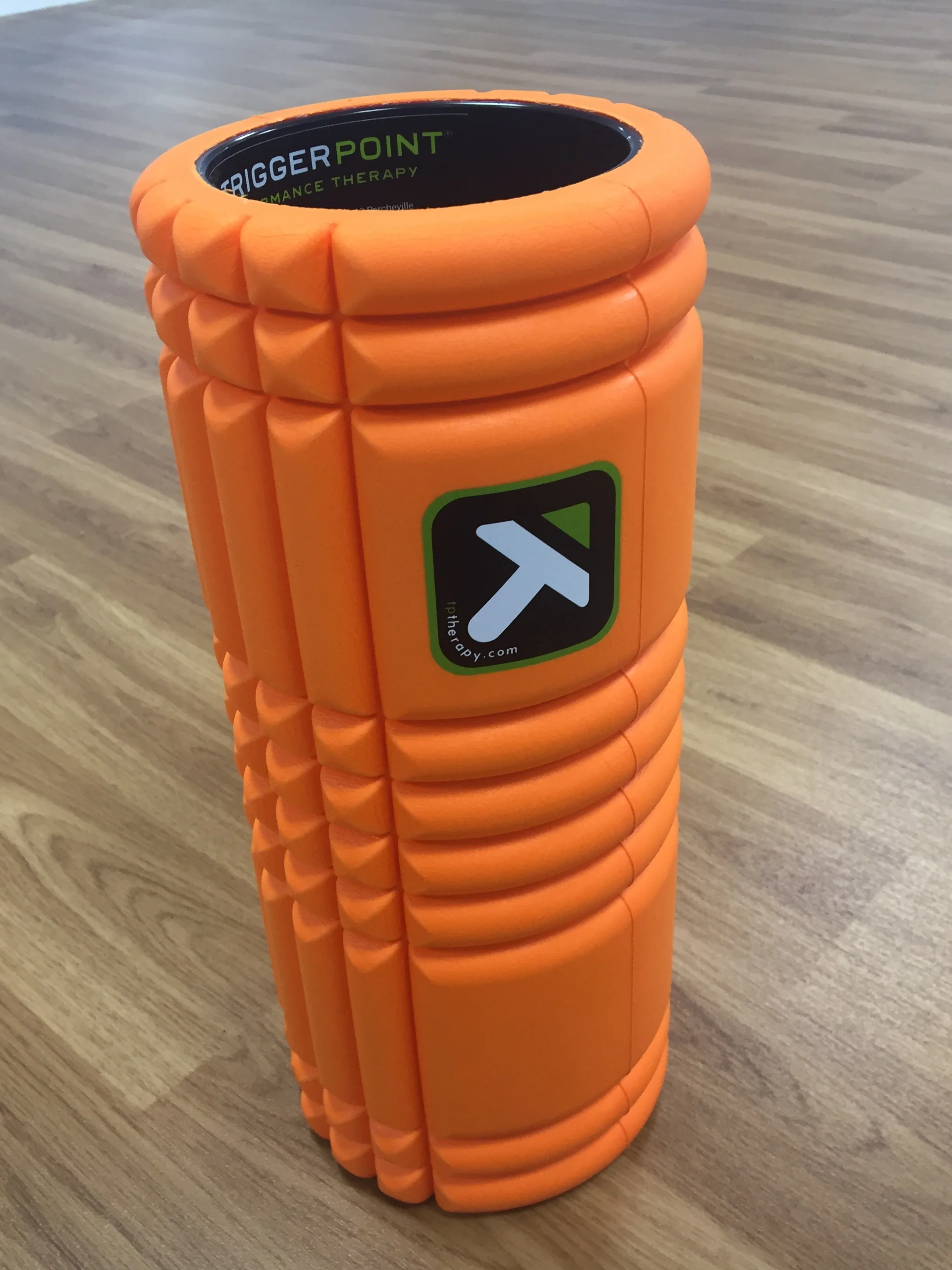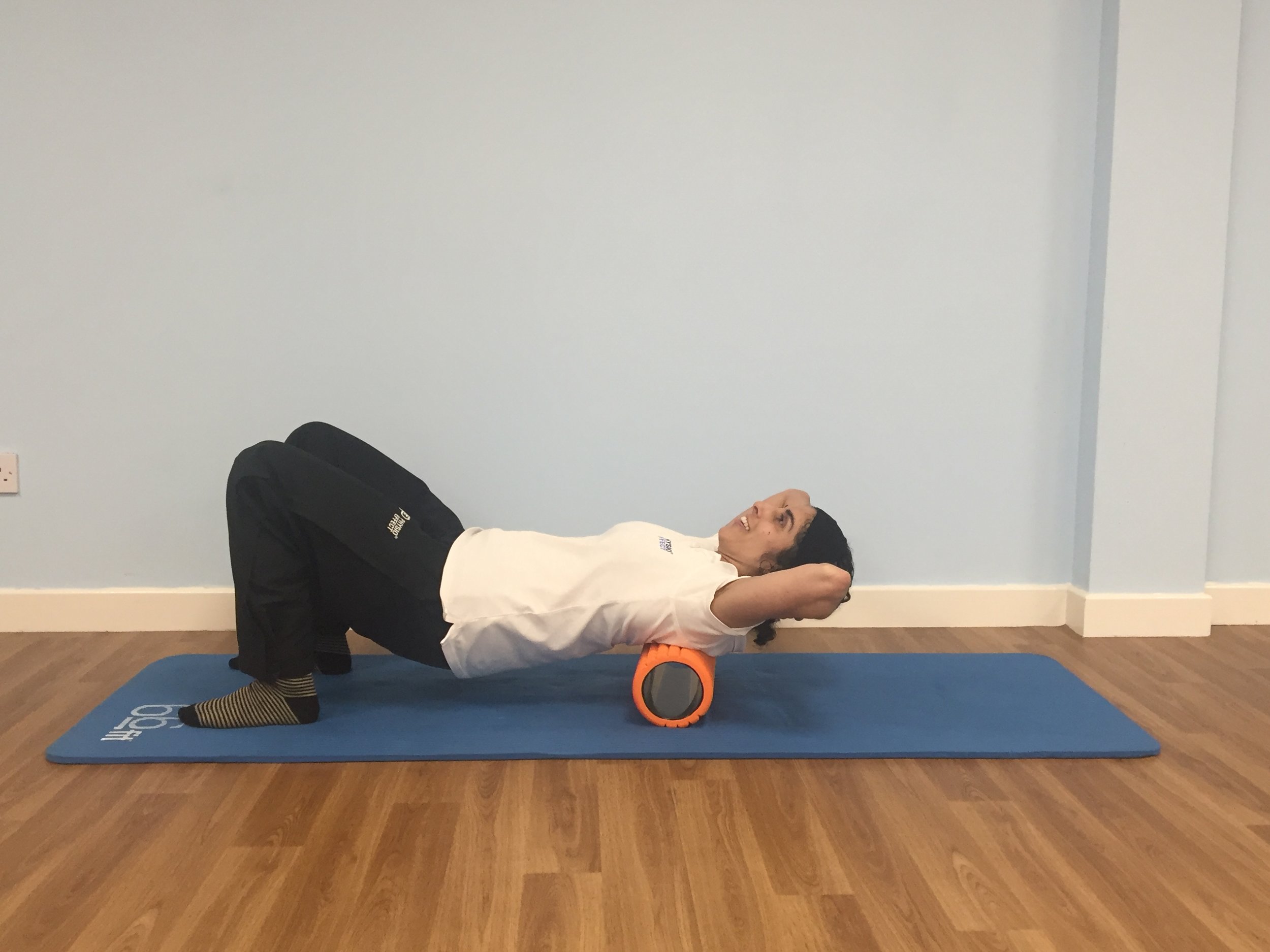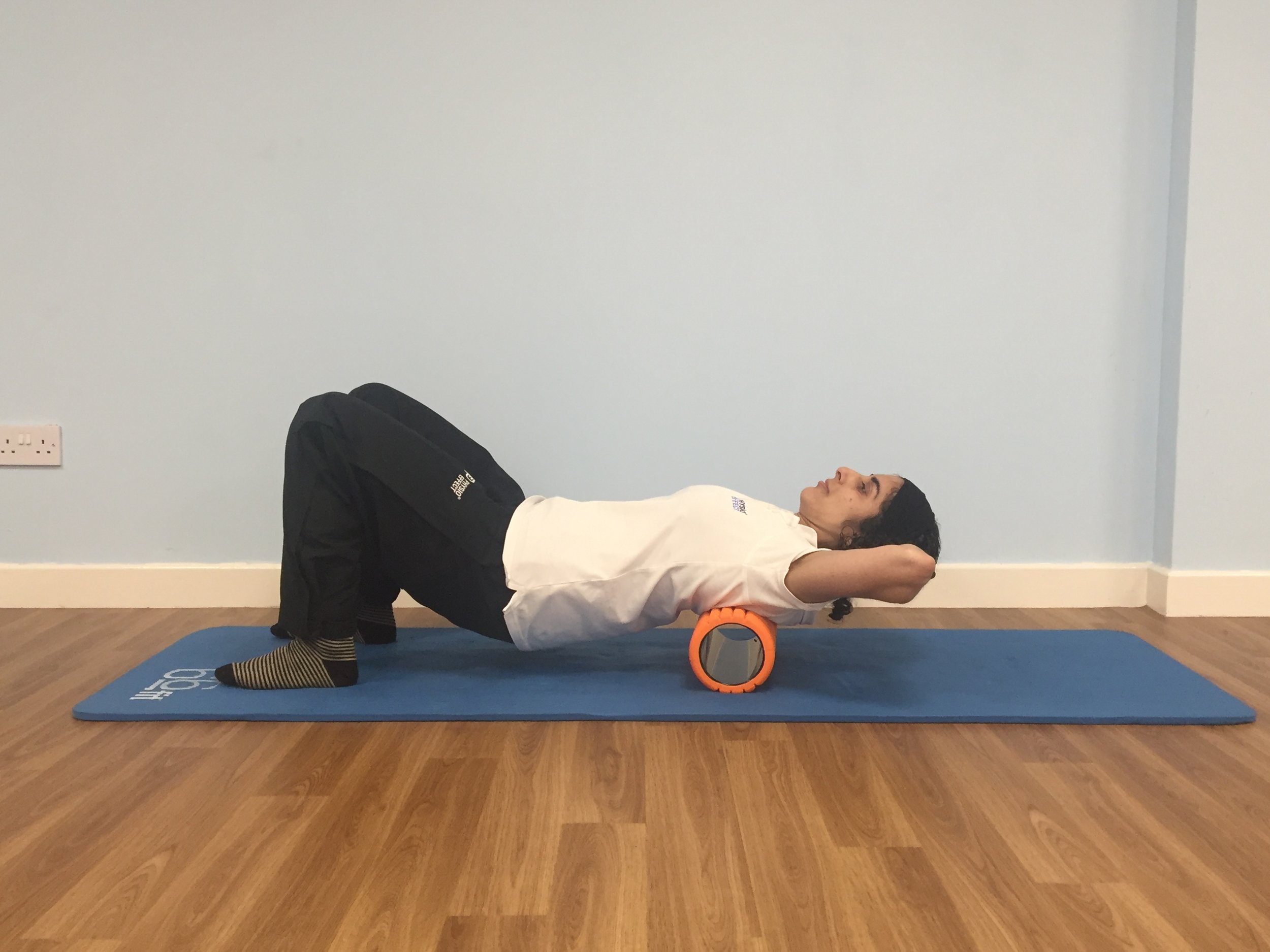Thoracic Mobility - The Key To A Pain Free Spine!
When your thoracic spine isn't moving as it should, it creates a domino effect throughout your body. This can contribute to neck, shoulder & lower back pain. Let’s drill down into how to take better care of your back and get that thoracic spine moving!
Unlock Your Movement Potential: Why Your Thoracic Spine is a Game-Changer! 😀
Written by Daniel Wray (Senior Physiotherapist & Mobility Coach)
Back pain is very common - Thoracic spine stiffness is often to blame
As someone who's spent over two decades in the clinic as a sports physiotherapist, I've seen first-hand how often seemingly unrelated aches and pains can be traced back to one crucial area: your thoracic spine. You know, that middle section of your back, between your neck and your lower back? It might not get as much attention as your neck or lower back, but trust me, it's a true unsung hero when it comes to keeping you moving freely and comfortably, no matter your age or activity level.
Think of your thoracic spine as the command centre for so much of your upper body movement. It's designed for rotation and extension, allowing you to twist, reach, and stand tall. But in our modern lives, spent often hunched over desks, phones, or even just relaxing on the couch, this vital area can become stiff and restricted. And when that happens, other parts of your body have to pick up the slack, often leading to problems!
The Ripple Effect: How a Stiff Thoracic Spine Causes Trouble
When your thoracic spine isn't moving as it should, it creates a domino effect throughout your body. Here's how it can contribute to those annoying aches and pains:
Familiar hunching over your desk increases thoracic spine rounding and stiffness
Neck Pain: If your mid-back is stiff, your neck has to work overtime to compensate for head rotation and movement. This extra strain can lead to tightness, headaches, and that familiar crick in your neck.
Shoulder Pain: Your shoulder blade sits right on top of your rib cage, which is connected to your thoracic spine. If your mid-back is locked up, your shoulder blade can't move properly, impacting your shoulder joint mechanics and potentially causing impingement or rotator cuff issues.
Lower Back Pain: When your thoracic spine lacks mobility, your lower back (lumbar spine) might try to compensate by over-rotating or extending, putting excessive stress on discs and joints, leading to that nagging lower back discomfort.
Move Freely, Live Fully: The Benefits of Thoracic Mobility
Thoracic Rotation Mobility can help improve back pain and stiffness
The good news is, improving your thoracic spine mobility can have a profound impact on your overall well-being. By restoring natural movement to this area, you can:
Reduce Pain: Alleviate strain on your neck, shoulders, and lower back.
Improve Posture: Stand taller and reduce that "hunched over" feeling.
Enhance Performance: Whether you're an athlete or just enjoy daily activities, better thoracic mobility can improve your ability to rotate, reach, and lift.
Breathe Easier: Your ribs attach to your thoracic spine, so improved mobility can even enhance your breathing mechanics!
Easy Moves for a More Mobile You!
Ready to get started? Here are some simple yet effective exercises you can incorporate into your daily routine to unlock your thoracic spine's potential. Remember to listen to your body and move gently. Consistent daily practice is your key to progress.
Foam Roller Thoracic Extension
Thoracic Extension Over a Foam Roller:
Lie on your back with a foam roller positioned horizontally across your mid-back.
Place your hands behind your head for support.
Gently extend your upper back over the roller, allowing your head to drop towards the floor.
Slowly roll up and down your mid-back, focusing on areas of stiffness.
Seated Thoracic Rotations
Seated Thoracic Rotations:
Sit comfortably in a chair with your feet flat on the floor.
Cross your arms over your chest or place your hands behind your head.
Gently rotate your upper body to one side, leading with your rib cage.
Hold briefly, then return to the center and rotate to the other side.
As you rotate try gently lifting your elbow to he ceiling adding side opening to rotation
Cat-Cow Stretch:
Start on your hands and knees, with your wrists under your shoulders and knees under your hips.
Cat: Exhale as you round your spine towards the ceiling, tucking your chin to your chest.
Cow: Inhale as you drop your belly towards the floor, lifting your head and tailbone.
Flow smoothly between these two positions 1-2 minutes
Cat - Rounded back
Cow -hollow back
Elevated Arms Thoracic Extension
Similar to cat-cow motion performed with your arms elevated & resting on a chair or bench.
Breathe in as you round up lifting your head and shoulders
Exhale as you sit down and back relaxing across your back and shoulder blades
Repeat slowly for 10-15 deep breath cycles
Breathe in as you round your upper back and shoulders
Exhale as you relax and sit back extending through your back and shoulders
Deep Squat Spine Rotations:
This is more advanced, please avoid if you are not comfortable or able to maintain a deep squat position
Get into a deep squat and hold, Block one knee on the inside with your elbow
With the opposite arm straight rotate and lengthen towards the ceiling
Follow the movement with your head and actively rotate your ribcage and sternum
Hold for a few seconds at the top position then return & repeat on the opposite side.
Work side to side for 30-60 seconds
Deep Squat - Spinal Rotations
Incorporating these exercises regularly can make a world of difference in how you feel and move. It's amazing what a little attention to your thoracic spine can do for your overall comfort and vitality!
Looking for something a little more challenging?
If you are physically able these videos below can help you progress your spinal mobility and can be done routinely to increase range of movement and reduce back ache and discomfort.
Like most things worth having mobility improvements are earnt by consistency of practice. Show up everyday and work on your areas of stiffness & weakness and you will reap the rewards of moving better & reducing pain!
Downward dog - Calves, hamstrings and Thoracic/Shoulder Stretch
3 Point Bridge- Full body mobility including hips, spine and shoulders
Thoracic Spine Windmills & rotations
thank you
Thanks for reading, please share with any friends, family or colleagues who could benefit.
We are always here to listen & help. Our specialist team can help you navigate and manage any ache, pain or injury.
Pain - Finding Relief & Taking Control
That ache in your back, the stiffness in your neck, the twinge in your knee – these are common experiences we all face from time to time. Pain is something we will all have to manage at some point in our lives. Your understanding and response to pain is crucial in optimally managing & ultimately reducing you pain
Understanding Musculoskeletal Pain: Finding Relief and Taking Control
Written By Daniel Wray (Sports Physiotherapist & Mobility Coach)
That ache in your back, the stiffness in your neck, the twinge in your knee – these are common experiences we all face from time to time. Musculoskeletal pain, affecting our muscles, bones, ligaments, nerves, and tendons, can range from a mild annoyance to a significant disruption in our daily lives.
It's natural to feel concerned when pain strikes, especially if it's intense. However, it's reassuring to know that most musculoskeletal pain, even when it feels quite severe, is not a sign of serious underlying damage or pathology. Often, it can be related to things like muscle strains, sprains, overuse, or even just prolonged awkward postures. Our bodies are resilient, and these minor issues usually resolve with time and proper care.
When Should You Seek More Urgent Investigation?
While most musculoskeletal pain is not serious, there are certain situations where it's important to seek professional medical advice promptly. Be mindful of the following:
Lower Back Pain - Can Be Crippling but Is Rarely Serious Pathology
Severe pain that comes on suddenly and unexpectedly, especially after an injury.
Pain accompanied by other symptoms like fever, unexplained weight loss, or significant weakness.
Pain that radiates down your arm or leg with numbness or tingling.
Loss of bowel or bladder control.
Pain that is constant and progressively worsening, especially at night.
A history of cancer or other serious medical conditions.
If you experience any of these "red flag" symptoms, it's always best to err on the side of caution and consult a medical professional.
Simple Daily Habits and Strategies to Reduce Pain and Cope Better:
The good news is that there's a lot you can do in your daily life to manage and reduce musculoskeletal pain. Here are a few simple strategies to incorporate:
Some key areas to manage in improving Pain Control
Stay Active: Gentle exercise, like walking, swimming, or yoga, can help strengthen muscles, improve flexibility, and reduce stiffness. Find activities you enjoy and make them a regular part of your routine.
Practice Micro-breaks and Regular Movement: If you spend long periods sitting or in the same position, incorporate short, frequent breaks to move around, stretch, and change posture. Even a minute or two of gentle movement every 30 minutes can help relieve muscle and joint tension.
Be Mindful of Movement: Pay attention to your body when you move. Avoid sudden, jerky motions and lift heavy objects correctly.
Manage Stress: Stress can often exacerbate pain. Incorporate relaxation techniques like deep breathing, meditation, or spending time in nature.
Ensure Adequate Sleep: Quality sleep is crucial for muscle repair and overall well-being. Aim for 7-9 hours of restful sleep each night.
Consider Heat and Cold Therapy: Applying heat packs can help relax tight muscles, while ice packs can reduce inflammation. Experiment to see what works best for you.
Stay Hydrated: Drinking enough water is important for overall tissue health. This will range upwards from at least 2-3 litres per day depending on your circumstances
You Don't Have to Live with Pain – Help is Available:
Professional Physiotherapy guidance can help manage and improve your pain
Living with persistent musculoskeletal pain can be frustrating and limit your ability to enjoy life. Please remember that you don't have to accept pain as a normal part of your day.
At Physio Effect, our experienced team of physiotherapists is dedicated to helping you identify the underlying causes of your pain and develop a tailored treatment plan to address your specific needs. Our skilled practitioners are experts in assessing movement patterns, muscle imbalances, and joint mechanics. We utilize a variety of effective techniques, including manual therapy, targeted exercise prescription, and comprehensive education, all designed to help you reduce pain, improve your physical function, and prevent future problems.
Taking that first step to connect with the team at Physio Effect can make a significant difference in your quality of life. We're here to listen, understand your unique situation, and guide you on your journey towards a pain-free and more active future.
Summary
In conclusion, while musculoskeletal pain is a common experience, it doesn't have to dictate your life. By understanding the common causes, recognizing when to seek further advice, and incorporating simple daily strategies, you can take proactive steps to manage and reduce discomfort. Remember that expert help is available, and the experienced team at Physio Effect is ready to provide tailored support to help you regain comfort and get back to doing what you love.
thank you
Thanks for reading, please share with any friends, family or colleagues who could benefit.
We are always here to listen & help. Our specialist team can help you navigate and manage any ache, pain or injury.
You can Use the links to Book an appointment now or Contact us with any questions
Mobility - What? Why? When? How?!
Do you struggle with constant niggling joint and muscle pains? You workout regularly but still feel stiff all the time? Do you need help understanding and implementing better mobility habits and practices? If yes then this blog is for you! Modern stressful and busy lifestyles often mean we neglect flexibility and mobility practices. Long hours of static postures cause us to stiffen up & this compounds over weeks, months and years. It’s time to start organising your mobility practices to move better & feel better!
Improving mobility requires consistent structure, practice & effort!
Written By Daniel Wray (Sports Physiotherapist & Mobility Coach)
What is mobility?
Mobility is the ability to move freely and easily, encompassing physical movement, flexibility, balance, and environment access.
Mobility is vital for daily activities and exercise, impacting overall performance and quality of life.
Improving mobility enhances physical function, reduces injury risk, and fosters independence. Prioritising mobility supports long-term health and well-being.
5 barriers to mobility practice
Physical Limitations
Joint pain, muscle weakness, and neurological issues can hinder mobility exercises.Psychological Factors
Anxiety, depression, and lack of motivation can create fear of injury, impacting engagement.Access to Resources
Limited facilities, equipment, or expert access restrict effective mobility practice.Knowledge and Awareness
Lack of understanding about mobility's benefits inhibits participation.Environmental Barriers
Poorly designed spaces and clutter discourage movement, obstructing mobility practice.
stop sitting & start moving!
Sitting Is the New Smoking!
In our experience the main cause of reduced mobility and increased joint pain and stiffness is a sedentary job or lifestyle. Sitting for over 40 hours a week leads to negative consequences. What we see regularly in clinic is huge frustration from people in this situation who do actively find time for exercise, sport & gym classes.
“I go to the gym 4 times a week so why am I so stiff & sore?”
The problem with modern life stresses and lack of time mean many of us compartmentalise exercise to one point in the day for perhaps 1-2 hours. Out with that we are too static often sitting or standing at desks for long unbroken periods. Structured & planned exercise classes or sport is great but we must also find ways to inject short, varied, but regular amounts of movement into our everyday activities.
Tips to improve Mobility practice
Prioritise Side bends & Rotational Plane Movements
Incorporate Daily Stretching & Mobility Flows
Dedicate at least 10-15 minutes each day to stretching. Focus on major muscle groups and areas that typically feel tight, such as the hips, shoulders, and spine. Consistency is key to improving flexibility and joint mobility.Engage in Mobility-Focused Activities
Activities such as yoga, Pilates, and tai chi are excellent for enhancing mobility. These practices encourage controlled movements and can help increase your range of motion, balance, and overall physical awareness.Incorporate Micro Breaks
Aim to move for 2-3 minutes every hour as a minimum. Large simple movements of all major joints helps to create pressure changes and encourage healthy fluid balance in our tissues and joints reducing the cumulative build up of static postures.
Include Dynamic Warm-ups
Before engaging in physical activity, perform dynamic warm-up exercises. Movements like leg swings, arm circles, and torso twists can prepare your body for more strenuous activity and promote better mobility throughout your workout.Prioritise Functional Movements
A strong body is able to move in all planes of motion. A lot of gym exercises and routines can be too hinge like and robotic in nature failing to promote adequate movements in all planes. Incorporate good accessory training to include rotational, side bend and functional movements.
Example Mobility Flows For Daily Practice
Back Mobility Exercise Flow - Try this routine to gently mobilise your spine
Hip Mobility Flow - Try this exercise flow to mobilise and loosen up stiff hips
We love a 3 Point Bridge. Movement is medicine, start taking yours!
Summary
Improving mobility and reducing pain & stiffness is no simple task but it can be done! Take positive action and start today dedicating time for movement and stretching as often as you can. Spend some time analysing your current practice and training and see where you can improve.
We help people improve mobility & reduce pain and stiffness on a daily basis. If you need help to understand your needs and to design & implement a plan unique to your goals we can help!
thank you
Thanks for reading, please share with any friends, family or colleagues who could benefit.
We are always here to listen & help. Our specialist team can help you navigate and manage any ache, pain or injury.
You can Use the links to Book an appointment now or Contact us with any questions
Working From Home Survival Guide
Is working from home making you ill and injured? Are you in pain & stiffer than ever? Are you feeling isolated and unsupported? The risks are real and you are not alone. This survival guide will help you make better choices to reduce pain & stiffness and look after your body and mind. What are you waiting for? Follow our top tips to move more, organise yourself and have a positive impact on your physical and mental health
Is Working from home breaking you? Do you feel:
WFH health risks are very real
Stiff and sore?
back, neck, joint or muscle pains?
headaches or vision problems?
overwhelmed?
fatigued?
irritable?
low mood?
The risks of working from home (WFH) to physical and mental health are significant and real.
If you are feeling any of these issues you are not alone. You need to take positive action now and improve your individual situation.
Below we will list our top tips for how you can act now to prioritise your health. In Summary you need to :
MOVE MORE
GET ORGANISED
OPTIMISE YOUR WORKSPACE
Take Positive Action and Get Organised To Improve Your WFH Situation
top tip 1 - move more!
The single most important thing you can do to improve your WFH health is to move more. If you roll out of bed, grab a coffee then plant yourself at your desk with no movement or plans to move then you are brewing trouble. The NHS recommends reducing your sitting time significantly to improve your health and reduce the risks of type 2 diabetes, some cancers and even early death!
Are you already struggling with pain & stiffness in your neck, shoulders, back or hips? Check out these links to our previous blogs for advice, stretching and mobility instructional videos:
Movement Is The Key - Could you try Yoga?
When we are static (sitting or standing still) compressive and dehydrating forces are at work on our joints and soft tissues. All of our major body systems slow down and become sluggish which in the longer term contributes to significant health issues. The phase ‘Sitting Is the new smoking’ has been coined to highlight just how serious the impact of sedentary lifestyles can be
Movement creates positive pressure changes and improved fluid movement through our body as well as stimulating our body systems to be more active and alert. All of this helps to balance and reverse the negative effects of being static. Research shows us that movement and exercise can also help reduce stress and improve your mood.
Try these ideas:
Make time to move or you will get injured or sore
Rise earlier - Fit at least 10+ minutes of movement in before you hit the desk
Step challenge - Set a challenging daily step goal and go about smashing it. You need to prioritise time to walk. Try breaking it up into multiple smaller chunks (10-20 minutes x 2-3) throughout the day
Take breaks - Do not sit and rust at your desk! Take multiple complete breaks away from your desk and work. Walk, stretch or exercise, it doesn’t really matter, just take a break & move
Get outside - Combine fresh air & movement. Great for refreshing body & mind
Exercise for fun - Find something you enjoy and can commit to on at least a semi regular basis (2-3 x per week). Gym, walking, jogging, yoga, swimming etc.
Daily step targets are a great way to increase your activity. Get walking!
top tip 2 - organise yourself
Set Regular Break / Movement Alarms
Failure to plan is planning to fail! You need to actively organise yourself to make smarter, healthier choices and start reducing the negative impact of WFH.
We are great at making excuses for negative behaviour as it is generally the easier/lazier option. Get organised & remove barriers to promote positive action.
Try these ideas:
Plan Micro-Breaks - Aim to move away from your work for a minimum of 2-3 minutes every hour. Ideally combine this break with a little movement, stretching & breathing. 2-3 minutes of movement hourly is infinitely more important than trying to undo 8+ hours of static WFH with an end of day workout.
Set Movement Alarms - Use smart watches, desktop reminders or a simple timer to remind you when it’s time to get up and move. As already mentioned, ideally aim for a few minutes movement every hour as a minimum. Don’t ignore it! Get up and move.
Drink at least 2-3 litres of water every day
Create Dedicated Space - Dedicate some space at home away from your office or workstation setup to stretch, move & exercise. Get a yoga mat down, gather any small equipment like foam rollers or exercise bands and have it accessible. Removing the barrier of having to get setup each time you want to exercise will significantly increase your compliance
Measure Water Intake - Aim to drink at least 2 - 3 litres of water a day. Many people are chronically dehydrated and don’t even know it. This contributes massively to muscle and joint pain, headaches and general fatigue. Poor water intake increases your risk of dysfunctional metabolism and chronic diseases. Your tissues and body systems need water to function so give it to them! Use a water bottle to track your consumption and trigger better habits
top tip 3 - optimise your work space setup
When it comes to WFH there is no perfect workstation setup but you can improve and optimise in some areas. This article by the New York Times gives some further ideas on equipment and optimal desk setup. However, there is no point in forking out thousands on space age chairs and desks if you sit on you butt and barely move for 8+ hours a day.
You can’t buy your way to healthier WFH and you must still prioritise movement, regular breaks and a structure to your day that gives you balance physically and mentally. Once that’s in place see if you can implement some of the following ideas:
Stand Instead of Sit. Use a riser to optimise your screen and mouse position.
Stand Instead of Sit - Standing is probably the lesser of 2 evils and tends to naturally lead to a bit more movement and reduced pressure on some areas like the neck and lower back. If your work station allows it alternate sit to stand regularly throughout the day
Use Equipment & Aids - Optimise your sitting & standing postures by utilising equipment. Perhaps your employer can supply equipment such as a desk riser for raising the height of your monitor. Ergonomic chairs and variations of mouse and keyboards are available to promote better positioning and reduce repetitive strain. Access what you can & make arrangements that suit your own setup.
Stretch & Move - Our bodies love symmetry but unfortunately WFH and office based work in general promotes repetition with repeated postures, positions and static behaviours.
At risk of repeating ourselves here you need to counter static behaviours by moving your muscles and joints regularly through a large range and routinely in the opposite direction to the postures you adapt while working. For example to counter tightness in the hips and lower back from sitting we should target arching our lower back and lengthening our front hip and thigh muscles. Check out our Mobility blogs and Videos here.
‘Cobra’ Back Bend Stretch
Lunge Hip Opener Stretch
WFH can be happier and healthier
Summary
It’s time for you to take positive action if you want to improve your WFH situation. Stop making excuses, organise yourself and make healthier choices now to improve your physical and mental well being. It’s up to you!
thank you
Thanks for reading, please share with any friends, family or colleagues who could benefit.
We are always here to listen & help. Our specialist team can help you navigate and manage any ache, pain or injury.
Use the links below to Book an appointment now or Contact us with any questions
Back Pain - A Self Help Guide
Back pain is very common. It’s frustrating at best and debilitating at worst. This guide will help you develop strategies for long term change to get rid of back pain and stay pain free long term. No magic bullet or ‘Guru’ advice here, just sensible and actionable tips allowing you to take control and start your journey to a pain free back.
Written by Daniel Wray (BSc Hons Physio/ PG Dip Sports Physio)
Back Pain?
We’ve all been there…..
Why does my back hurt?
Back pain is common, if you’re reading this i’m sure you have suffered at least one episode of back pain in your lifetime and in all likelihood more than that. It’s frustrating and restricting and can have a huge negative impact on your quality of life.
There are many reasons for back pain and unfortunately it’s rarely a quick fix. The most common form of back pain is often referred to as mechanical pain which is an umbrella term describing dysfunction in the soft tissues and joints preventing or impeding normal function. This may be stiffness, weakness, muscle shortening, joint wear and tear or any combination of these plus other factors.
In the absence of acute trauma back pain rarely appears suddenly or overnight and for most it’s a gradual and cumulative process related to lifestyle. Our modern lifestyles are simply too sedentary with too many hours spent in static positions meaning our joints and muscles don’t get the movement stimulus they need to stay flexible, hydrated and healthy.
For many people what began as a minor back ache or stiffness spirals steadily into chronic pain and disability and it can seem like you’re stuck in a repetitive cycle of injury and pain. We try to make changes but the daily grind means we continue to rack up hours of sedentary, static, and repetitive behavior trapping us in this negative cycle. The pain can force further lifestyle changes meaning less movement and exercise which reinforces the negative cycle and it can seem impossible to break free. Having a dodgy sore back slowly becomes the norm and we just accept it and carry on.
It’s not all bad news - here’s what you can do…
It all seems pretty grim and depressing right? Well the good news is that for the most part the majority of back pain, even when extremely painful and debilitating, is not due to serious pathology and it can get better. There are of course exceptions to this and we would always advise you seek advice from a qualified health professional if you have serious concerns about your back pain.
The bad news, if you look at it that way, is that the fix is rarely instant and usually requires significant effort on your part to make lifestyle changes and prioritise time every single day to look after your back. Of course if you Google hard enough (we’ve all done it) you will find some ‘Guru’ promising an overnight fix in exchange for a significant amount of your hard earned cash but truthfully the magic bullet doesn’t exist. Below we have listed some strategies you can implement to make a real difference.
6 self help strategies to help manage back pain:
1- Keep moving. Complete rest is not going to help and generally increases stiffness, pain and fear avoidance behaviors. Of course we must adapt our movement depending on the level of pain and there may be a need to avoid certain postures, positions or movements for a short period of time which is fine. I don’t recall any scenario with a patient where we couldn’t find at least one simple movement they could do to keep some gentle activity in their back to promote healing and relaxation while building confidence that they are not going to stuck in pain forever. Experiment with different movements and stretches (see below video) gently and slowly and see what you can manage comfortably and that will give you a starting point which you can gradually add other movements to as your pain allows.
Lunge with arm and spine rotation
2- Establish routine & be proactive not reactive. You need to act consistently and with purpose. Don’t wait until your pain is crippling to decide you need to try some exercises to relieve it. Even if you’re feeling okay find a rhythm that allows structured gentle movement and exercise to be part of your daily routine ideally multiple times a day. Frequent exercise micro breaks to interrupt static postures will reduce the build up of pressure and stiffness and are more desirable than trying to undo hours of sedentary behaviour with a single bout of exercise. Think 2-3 minutes activity every hour rather than a 30 minute blast at the end of the day. Use a timer to remind you.
3- Accept responsibility & seek guidance. It is your body and your back and you need to find a way forward, nobody can do it for you. Don’t pass responsibility onto any therapist (no matter what some ‘Guru’ promises) and assume that by chucking money at it that will be enough to fix you. Do find help from someone you trust who has your best interests at heart and involves you in all aspects of any treatment or rehab plan. Passive treatments such as massage, acupuncture, and manipulation can be great for pain relief but long term are only as good as the agreed exercise plan and responsibility you take in changing your lifestyle. Be wary of any therapist promising to fix you but providing no education or prescription of exercises you can use to help yourself.
4- Exercise for fun. Find a form of exercise you genuinely enjoy and commit regularly to it. Don’t drag yourself to the gym if you hate every minute of it, exercise should be enjoyable and a way to relax your mind as well as your body. Try new things and see what you enjoy. Ultimately your long term compliance will wain if you pursue something because you feel you have to rather than because you really want to.
Back Strengthening - Extensions on the GHD machine
5- Manage stress. One of the biggest silent assassins to any life goal is high stress levels. You can have all the good intent in the world in changing lifestyle and exercising more but if you are under high levels of stress you can easily sabotage any progress. I realise this is a broad blanket statement and stress management is a big topic beyond the scope of this article but at the very least be aware of how it contributes and can damage your progress, then start to look for solutions.
6- Be patient. You won’t change things overnight and chances are you will have many peaks and troughs in your recovery. This is normal. Try to be patient and remember a backward step with increasing pain symptoms is not the end of the world, try to continually adapt but keep taking positive actions even when you feel frustrated and annoyed. If you follow the steps above you should see over time the more severe episodes of back pain decrease while your ability to manage and recover from any acute episodes will improve.
Picking Exercises - Where to start?
It’s imperative to get moving ASAP with pretty much every kind of back pain or injury but the exact type of exercise or stretch you choose to get started with will differ depending on your level of pain, stiffness and disability. Below is a back mobility exercise flow covering a multitude of different exercises and positions. Try it but STOP if you feel any specific movement aggravates your pain. At most a slight awareness of stiffness or aching is permissible but do not force anything and take it slowly and gently.
You may decide that only a couple of these exercises work for you in your current situation and that is fine, identify what you can do and exclude what you can’t. That will be your start point and I would advise doing these exercises a minimum of 3 times per day but ideally more frequently at least initially. As you become more comfortable hopefully you can add more of the movements to your repertoire.
Long term most people will require a combination of strength and flexibility exercises but it is important that these are specific to your own individual requirements. The routine below is provided as a starting point but is not all encompassing so please seek advice on your own needs but do use these stretches to try and initiate positive change through movement. The exercises are broken down individually in the pictures below the video & you can download a PDF cheatsheet to keep for your reference at the end of this blog.
Back Mobility Flow Video:
Seeking Guidance? We Can Help
Our experienced team at Physio Effect Glasgow are specialists in back pain and have helped 1000s of people recover and get back their quality of life. We talk the talk and walk the walk and will combine exercise based rehab with highly skilled hands on therapies to ensure you get the best possible treatment.
Most importantly we will listen and work with you in partnership to identify your specific issues and formulate an agreed unique treatment plan. We will relieve your back pain and give you long term self management strategies to strengthen your back and reduce the chance of pain relapse.
Please contact us if you have questions or to book an appointment and get your journey to back pain recovery under way.
Exercise Breakdown:
Here is a breakdown of each of the exercises included in the back mobility flow video. These are available in a handy PDF download from the Subscription box at bottom of the page.
Exercise 1
Cat & Camel Stretch
Begin in all 4s position. Cat posture - Allow your spine to soften and hollow along its entire length. Tilt your tailbone gently to the ceiling. Relax you lower back, rib cage, shoulders and neck
Camel Posture - Arch your whole spine slowly and gently to the ceiling in one large ‘C’ shape. Tuck your tailbone between your legs
Hold each position for around 10 seconds. Transition from one to the other 6-8 times.
1- Cat Pose
2- Camel Pose
Exercise 2
Childs Pose to Cobra
Begin in all 4s position. Childs pose - Gently sit bottom back towards heels as far as is comfortable opening knees and hips softly and as required
Cobra Pose - Allow weight to come forward and lower hips gently to floor. Stay relaxed in hips and lower back and if required bend elbows slightly so that hips can rest in contact with floor.
Hold each position for around 10 seconds. Transition from one to the other 6-8 times
1- Childs Pose
2- Cobra Pose
Exercise 3
Childs Pose Side Bend
Begin in Childs Pose - Walk you hands around to one side into side bend aiming for at least a 45 degree angle, you should feel a good stretch down your side. Hold 20-30 seconds.
Walk hands around in same way to other side and again hold 20-30 seconds in side bend.
Repeat 2-3 times on each side
1- Childs Pose
2- Side Bend Right
3- Side Bend Left
Exercise 4
Lunge Hip Flexor Opener
Begin in Lunge position. Gently engage your lower tummy muscles and tuck your pelvis in. Aim to feel a stretch in the front of your hip and top of thigh
Gently engage your buttock muscles and lean slightly forward taking care not to arch your lower back
Hold the position 30-60 seconds. Repeat 1-2 times left and right
1- Lunge Hip Flexor Opener
2- Lunge Hip Flexor Opener - Forward Lean
Exercise 5 - Part 1
Lunge Hip Opener with Alternate Arm Rotations
From Lunge position reach hands forward and rest on floor beside front foot. Take outside arm and reach under and between legs ‘threading the needle’ holding for a few seconds
With the same arm rotate outward and upward toward ceiling trying to get arm to a straight vertical position, hold for a few seconds then return to ‘thread the needle’
Repeat this 10 times
1- Lunge Position Hands Forward on Floor
2- Lunge Position Hands Forward ‘Thread The Needle’
3- Lunge Position Hands Forward - Rotate arm vertically reaching for ceiling
Exercise 5 - Part 2
Lunge Hip Opener with Alternate Arm Rotations
After completing Part 1 of this series stay in the same position but extend out your back leg as far as is comfortable
Take inside arm now and rotate upward to the ceiling trying to achieve the straight arm vertical position, Hold for a few seconds
Bring the same arm down and with bent elbow drive your elbow towards the floor down the inside of your shin. Hold for a few seconds then rotate back to the vertical arm position
Repeat this 10 times
4- Lunge Position Extend Back Leg
5- Lunge Position Inside Arm Rotate to Ceiling
6- Lunge Position Inside Elbow Drive to Floor
Exercise 6
A-Frame Walk to Squat
From the all 4s position drive your hips into the air with straight knees and gentle lower your heels towards the floor into the A-Frame (it does not matter if you can’t fully extend knees or reach the floor with your heels). Hold for 10 seconds feeling stretch in back of legs
Keeping hands on floor slowly walk feet in towards hands and slowly sit down into a squat, hold for 10 seconds
Walk back to A-Frame position and hold for another 10 seconds
Repeat 4-6 times
1- A-Frame Position
2- A-Frame Walk to Squat
3- A-Frame Walk to Squat 2
4- Finish in Squat
Thank You
Thank you for taking the time to read this post, we sincerely hope that you find it useful and can use it to implement some positive changes and reduce your back pain. Take your time and work at your own level but be persistent and try to gradually improve on your own baseline.
Please download your own FREE PDF Cheatsheet to keep and to help with your practice and share this post with anyone who could benefit. If you have any questions or comments please just ask we would love to hear from you. Stay healthy and move well.
Animal flows - What, How and Why?
Animal flows are a great addition to any exercise plan, warm up routine or injury prevention plan. Learning to move like a monkey, frog, or bear helps to build full body strength, mobility and motor control which in turn will make you a more awesome human and less prone to injury. This blog with video tutorials will explain what these movements are, how to utilise them and why you should should be doing them
What are Animal Flows?
Animal flows essentially refer to movement and exercise patterns where we imitate different types of animals such as bears, monkeys, frogs or lizards. Moving in these patterns can be very challenging, especially for the stiff & inflexible among us, but can also be really fun & provide significant benefits.
Deep Squat
Practicing animal flows can help improve strength, flexibility, mobility and overall motor control which in turn will help to make you a better functioning human and less at risk of injury. These movements can really challenge us in unconventional ways demanding our joints and muscles learn to control movement in patterns and ranges we would rarely otherwise practice. They can provide a great way to warm the body up in preparation for other forms of exercise or can even act as a stand alone training session. Once you have tried some of these movements for a few minutes you will understand why!
Where do I start?
As with all areas of training and exercise when attempting something new or different our advice is always start slow and work safely within your own levels of capability. Never push through pain or injury and if in doubt about whether this is appropriate for you please seek advice from a qualified professional.
Very few people will be able to perform controlled animal flow movements perfectly or even well at the beginning. When incorporating these kinds of exercises with my patients it’s essential we first establish their base level where they feel safe to practice but also feel that it is challenging. I would advise starting with getting comfortable in the static positions required as the foundation for the movement. In this post we will look at 2 positions - Deep Squat & A-Frame (Downward dog). These are the foundation starting postures for progression onto the animal movements monkey, frog and bear.
Deep Squat
The squat is a great foundation exercise for strength and mobility in the lower limbs and yet for so many people it is a real area of weakness and frustration. A lot of us slowly lose our ability to sit into a deep squat mainly through neglect and lack of practice combined with our static and sedentary western lifestyles. We become weak, stiff and tight and can no longer control the range of motion required to allow a deep squat. We rarely challenge ourselves to sit into a deep squat position let alone spend time exploring and improving on our range and control in this position. So first things first lets get a measure of your baseline squat function - check out this video and see how you get on.
It may take weeks or months of work to improve your squat mobility and that’s okay. For a more detailed look at improving your hip and back mobility please click the links to see our previous blog posts on these areas. You can use these routines alongside your deep squat holds to improve your squat function.
If you feel up to increasing the mobility challenge of your deep squat lets check out this next video requiring some active hip rotation movements at the bottom of the squat - a great way to improve your range of motion and strength.
I would recommend slowly building these exercises into your routines, aim for 20-30 second rounds initially performed for 3-4 sets thereby accumulating 2-3 minutes in the deep squat. Try this at least 2-3 times per week. Long term the idea is to become comfortable spending longer periods in the deep squat and find it relatively easy to perform movements from this position. Try to build up to 5 minutes total in the deep squat per day of practice over several weeks.
Monkey & Frog Mobility
These animal flow progressions are suitable once you have a comfortable squat allowing you to sit at least to parallel depth without the need of hand support. Don’t worry if you’re not there yet, keep practicing the squat, back and hip mobility exercises and you can move on to these once you feel confident.
These exercises are difficult and physically demanding but the pay off of regular practice will be improved squat mobility, increased lower limb strength and motor control with an associated reduced injury risk in these areas. Give each of these a try and see how you get on.
Add these to your regular practice at least 2-3 times per week initially
Begin with 20-30 second rounds aiming to build up to 1-2 minutes or longer
Look to accumulate time in the positions - Try a 5 minute timer & while stopping for breaks when required, try to spend as much time actively moving in these flows
Ideally we want to develop a relaxed freedom of movement where you can drop comfortably into a deep squat and easily move through monkey and frog patterns. You can mix and match the movements to create variation in the flow and challenge your strength and mobility through mixed planes of movement. Don’t expect overnight success but as with all training with hard work and consistent practice you should be able to improve allowing you to move better and feel better.
A-Frame (Downward Dog)
This stretch position is probably best known in yoga circles, most people will of at least heard of the Downward Dog. Another term we will use is A-Frame which refers literally to the fact we are trying to get our body into a position whereby it looks the a capital letter ‘A’. This position is another staple in many exercise forms and for good reason, it challenges the flexibility and strength of our body in many areas. The shoulders, back, hips, knees and ankle joints will be tested and for many people deficiencies in strength and range of movement will limit the quality and range available in attempting this position.
For many of us just attempting this posture will be tough and tiring. A lot of you will be feeling significant resistance in the backs of the legs (hamstrings and calves) and through the shoulders and upper back. Build slowly and increase the time spent in the stretch as you feel able, again looking to improve on your own current baseline level. Before attempting bear movements from this position we can work on a couple of simple variations which are shown in the video - slow marching on the spot and active shoulder extension pushing the head and shoulders through. Let’s give it a try and see how you get on.
Bear Movement Flows
The bear crawl can be utilised as a full body exercise to develop strength, flexibility and control in many areas. It is challenging and will take time to develop the skill and movement control required to perform it well but as with all these exercises your only goal should be to steadily improve on your own current baseline level. Once you have developed some comfort and control with the A-Frame stretch the first Bear Crawl movement we will try is with straight arms and straight legs as demonstrated in the video below. The key here is control so take your time and just do what you can, even if it’s only a few seconds initially, you can build on that. Let’s give it a go.
In the next video we demonstrate a number of bear crawl variations to give you some more options to explore. Depending on your own levels of mobility and strength you may find some options easier and others harder but it is great to play around and explore a variety of positions to find any weaknesses or restrictions and ensure a variety of stimulus is achieved. The key is to safely work on your own issues and don’t be afraid to explore positions that are challenging as long as you do so gradually.
Add these to your regular practice at least 2-3 times per week initially
Try:
Straight arms & legs
Bent arms, straight legs
Bent arms, bent legs
Straight arms, bent legs
Begin with 20-30 second rounds aiming to build up to 1-2 minutes or longer
Move forwards, backwards and sideways
Look to accumulate time in the positions - Try a 5 minute timer & while stopping for breaks when required, try to spend as much time actively moving in these flows
Summary
In summary adding animal flow movement practice into your regular exercise routines or habits can have significant physical benefits by helping to improve full body strength, mobility and motor control. It is a challenging but fun way to mix up your normal exercise routines and pushes your body to explore a variety of joint postures and positions that are not routinely trained or strengthened. This variety of stimulus will help to ensure strong and healthy muscle and joint function. Enjoy exploring and playing with these movements and ultimately you can learn to move better & feel better.
Thank You
Thanks for taking the time to read this guide, we hope you find it useful. Please share with anyone who might benefit and if you have any questions comment and let us know. Please subscribe to our mailing list to receive more interesting and useful blogs. Good luck and remember to move better & feel better
Stiff back? Try our simple six step mobility routine
6 step mobility stretch routine to ease back stiffness and relieve back pain. Practice daily and you will see improvements in your range of movement and alleviate tension, stiffness and pain in your back.
Back Pain?
We’ve all been there…..
What’s up with my back?
We’ve probably all struggled with a stiff achy back at some point. The reality is that our modern lifestyles are often dictated by technology and we just don’t move enough to maintain healthy joints and soft tissues. If you truthfully counted up how many hours per day or week you spend in sedentary / static positions whether working from a computer, driving, or binge watching TV and social media what would that number look like? How would it compare with hours spent being active, stretching, moving and getting some exercise? Chances are you are in the majority with your results skewed in the wrong direction and sedentary hours winning hands down.
Even for those of us who do exercise regularly it’s often at the back of a long day of not moving much. There is often a misconception that working out a few times a week should be adequate to ward off the stiffness and tightness that comes from our daily work routines. While of course some exercise is better than none what most of us need to do is work harder at incorporating small amounts of varied regular movement into our everyday routines. Micro breaks of several minutes every hour are a great way to break up the day & if you can practice a few hip and back movements and stretches with these then that’s a winning combination.
Most of the back pain we suffer is not serious (but do ensure you have checked with a medical professional) even when the pain and stiffness reach fairly extreme and debilitating levels. It is most often a cumulative and gradual process which results in reduced joint and tissue flexibility and a lower threshold or tolerance for simple tasks.
You may have a sensation of achy stiffness and tightness in your back and feel the need to fidget and change position constantly just to get comfortable. Sometimes acute painful events occur as the result of a simple daily task like putting on your socks and you can feel trapped in a cycle of stiffness, pain and vulnerability.
These symptoms most often aren’t indicative of something seriously wrong but rather your body is sensing changes it doesn’t like and is giving warning that something needs to change. X-rays and MRI scans aren’t normally helpful, unless being used by a medical professional to exclude other suspected pathology, and more often than not can cause confusion and fear which can negatively impact behaviour and recovery.
What can I do?
All is not lost and it’s never too late to make positive change. For most of us that can be very simple in the form of developing strategies that encourage us to move more in our daily routines. Try these pointers:
Be positive and take action of some kind. Note anything that seems to help or has a positive effect on how you feel and work to develop that
Focus on what is within your control to change and don’t worry or get hung up on the things you cannot do or cannot change
Develop simple daily habits and routines that encourage an increase in regular movement, exercise, and stretching
If you plan on being static/sedentary for extended periods plan micro-breaks of 2-3 minutes at least every 60 minutes and include some walking and simple stretching movements
Try to find a physical activity or exercise that you enjoy and doesn’t feel like a chore as you are much more likely to perform it regularly and achieve a long term change
Consider other lifestyle factors where you can implement simple change - e.g. drink more water, increase sleep, meditate or practice deep breathing & reduce daily screen time usage.
Let’s get started!
Below is a mobility routine for your back of 6 different exercises performed as a movement flow to get you started. Always begin slowly and gently and work within your own comfort limits. If you can only do part of the movement or a modified / reduced range that is fine, just do what you can. Try them every day and perhaps even multiple times per day if you’re able and you will gradually start to feel better and move better. Ideally try the whole routine or you can divide it up into single exercises and see which ones you find give you the most relief but aim to practice all the movements every day.
Back Mobility Flow Video:
Exercise 1
Cat & Camel Stretch
Begin in all 4s position. Cat posture - Allow your spine to soften and hollow along its entire length. Tilt your tailbone gently to the ceiling. Relax you lower back, rib cage, shoulders and neck
Camel Posture - Arch your whole spine slowly and gently to the ceiling in one large ‘C’ shape. Tuck your tailbone between your legs
Hold each position for around 10 seconds. Transition from one to the other 6-8 times.
1- Cat Pose
2- Camel Pose
Exercise 2
Childs Pose to Cobra
Begin in all 4s position. Childs pose - Gently sit bottom back towards heels as far as is comfortable opening knees and hips softly and as required
Cobra Pose - Allow weight to come forward and lower hips gently to floor. Stay relaxed in hips and lower back and if required bend elbows slightly so that hips can rest in contact with floor.
Hold each position for around 10 seconds. Transition from one to the other 6-8 times
1- Childs Pose
2- Cobra Pose
Exercise 3
Childs Pose Side Bend
Begin in Childs Pose - Walk you hands around to one side into side bend aiming for at least a 45 degree angle, you should feel a good stretch down your side. Hold 20-30 seconds.
Walk hands around in same way to other side and again hold 20-30 seconds in side bend.
Repeat 2-3 times on each side
1- Childs Pose
2- Side Bend Right
3- Side Bend Left
Exercise 4
Lunge Hip Flexor Opener
Begin in Lunge position. Gently engage your lower tummy muscles and tuck your pelvis in. Aim to feel a stretch in the front of your hip and top of thigh
Gently engage your buttock muscles and lean slightly forward taking care not to arch your lower back
Hold the position 30-60 seconds. Repeat 1-2 times left and right
1- Lunge Hip Flexor Opener
2- Lunge Hip Flexor Opener - Forward Lean
Exercise 5 - Part 1
Lunge Hip Opener with Alternate Arm Rotations
From Lunge position reach hands forward and rest on floor beside front foot. Take outside arm and reach under and between legs ‘threading the needle’ holding for a few seconds
With the same arm rotate outward and upward toward ceiling trying to get arm to a straight vertical position, hold for a few seconds then return to ‘thread the needle’
Repeat this 10 times
1- Lunge Position Hands Forward on Floor
2- Lunge Position Hands Forward ‘Thread The Needle’
3- Lunge Position Hands Forward - Rotate arm vertically reaching for ceiling
Exercise 5 - Part 2
Lunge Hip Opener with Alternate Arm Rotations
After completing Part 1 of this series stay in the same position but extend out your back leg as far as is comfortable
Take inside arm now and rotate upward to the ceiling trying to achieve the straight arm vertical position, Hold for a few seconds
Bring the same arm down and with bent elbow drive your elbow towards the floor down the inside of your shin. Hold for a few seconds then rotate back to the vertical arm position
Repeat this 10 times
4- Lunge Position Extend Back Leg
5- Lunge Position Inside Arm Rotate to Ceiling
6- Lunge Position Inside Elbow Drive to Floor
Exercise 6
A-Frame Walk to Squat
From the all 4s position drive your hips into the air with straight knees and gentle lower your heels towards the floor into the A-Frame (it does not matter if you can’t fully extend knees or reach the floor with your heels). Hold for 10 seconds feeling stretch in back of legs
Keeping hands on floor slowly walk feet in towards hands and slowly sit down into a squat, hold for 10 seconds
Walk back to A-Frame position and hold for another 10 seconds
Repeat 4-6 times
1- A-Frame Position
2- A-Frame Walk to Squat
3- A-Frame Walk to Squat 2
4- Finish in Squat
Thank You
Thank you for taking the time to read this post, we sincerely hope that you find it useful and can use it to implement some positive changes in your daily routines. Take your time and work at your own level but be persistent and try to slowly improve on your own baseline. Please download your own FREE Cheatsheet to keep and to help with you practice and share this post with anyone who could benefit. If you have any questions or comments please just ask we would love to hear from you. Stay healthy and move well.
Childs Pose
Stiff achy hips? Tightness or weakness and what can you do about it?
Complete hip mobility routine to increase range of motion, reduce pain and improve function. Explore your own limitations and work to improve them with daily practice of this routine. Rid yourself of stiff achy hips and restore strong, healthy movement while improving athletic ability.
Why are my hips sore?
Deep Squat
Chances are if you’re reading this you have at least one hip and at some point it has given you trouble. Hip pain or stiffness has likely gotten in the way of your daily activities or restricted your ability to exercise on more than a few occasions. Our hips are at the centre of our body’s movement, so if they are functioning poorly then our ability to move freely and unrestricted will be compromised. Poor hip function can cause local issues around the hip but often contributes to pain and dysfunction in other areas like the lower back and knees.
The primary reason for developing hip pain for most people is a lack of movement and excessive sedentary behaviour, an all too common theme in our modern lives. You may workout regularly but chances are you still accumulate a lot of static postures through work or leisure and it’s unlikely that your exercise habits routinely explore and work the hip joints and muscles to anywhere near their full range or capacity. Though most hip pain is not serious and can be helped with the right exercise, we recommend consulting a health professional if you are worried or have persistent symptoms.
Modified Pigeon with Active Hip Internal Rotation
Am I Stiff or Weak?
Most likely it’s a combination of both. There is a lot of confusion out there around the terminology of flexibility, mobility and strength. Essentially flexibility can be considered passive and is about the soft tissues (muscles, tendons and ligaments) ability to temporarily elongate to allow movement through a range while mobility centers around our ability to move through a range of motion with control before becoming restricted. Mobility requires strength to control your flexibility.
Take for example someone who can squat 200 kilos to a parallel depth. This would obviously be considered strong in that range. However if the same individual cannot perform a body-weight squat below parallel depth without falling over or requiring support then we could say they have poor squat mobility. Passively if they can still achieve a deep squat position using some support we can say that they have reasonable flexibility in their soft tissues to allow this. Ideally this individual will work to improve their mobility so that they have better strength to control a greater degree of flexibility i.e they can drop comfortably and controlled into a deep body weight squat without assistance.
Should I Stretch or Strengthen
Again for most people the answer here is both but the key is identifying exercises that allow you to improve on both simultaneously whilst also offering functional value. Being inflexible is not great as your natural joint range of motion may be restricted and eventually painful. Inflexibility can lead to struggles with basic everyday activities like bending to pick something up or getting in and out of bed or your car. If you are weak then as discussed before you will not be able to control your flexibility or movement again making you more vulnerable to injury and pain.
This is where we need to be smart and specific in identifying our own needs and training with functional goals and targets in mind. You may have great flexibility and touching your toes is a breeze but when asked to do a basic lunge you lack the strength, balance and co-ordination. Conversely as with our example above you may have great strength for lifting weight but only in a limited range and the idea of touching your toes or sitting in a deep squat seems ridiculous. There is no single one recipe to fix all here but in essence mobility training will work both our strength and flexibility needs, we just need to identify the right exercises.
Try this mobility routine we have created to help identify your own personal problem areas. What to you find most difficult and are you struggling due to tightness, weakness or a combination of both?
Up for a challenge? Try this routine a few times and note the 3 exercises or positions which you find most restricted or difficult to perform. Now practice them consistently at lease 3 times per week for the next 4-6 weeks and see what changes and improvements you can achieve
At the bottom of this blog you can see each of the individual exercises that make up our hip mobility routine. Click the link below to download your FREE PDF copy of these exercises including some key tips .
Challenge to Change
For the vast majority of people our lives and even our exercise or training keep us moving in basic linear patterns (up and down). We don’t often (if ever) challenge our hips with lateral or rotational exercises and most people end up weak and unstable in these positions compromising their hip health and function. That’s why we designed these routines to explore and challenge these less common positions.
This next video demonstrates 3 more advanced hip mobility exercises that you can try. Please only attempt what you feel able and do not work into pain or through injury. Try the exercises in the video below and see how you feel. Chances are you will find this very tough but they are great exercises to improve overall hip mobility and function so if you feel able add them to your regular routine and with consistent practice you should see real improvements.
Exercise 1
Seated hip Internal / External Rotation
Begin in sitting leaning back on straight arms, knees and hips bent and relaxed shoulder width apart with feet flat on floor.
Gently and with control lower both legs to one side trying to touch the outside of one knee and inside of the other knee to the floor. Don’t worry if this range is too much, just work as far as you feel is challenging but comfortable. Return to start and repeat to opposite side.
Perform this movement for 60 seconds
1- Floor Sitting, Lean back on hands, high chest
2- Slowly Rotate Both Legs to one side
Exercise 2
Deep Squat Hip Internal / External Rotation (Advanced Option)
Begin in a deep squat. Ensure heels remain in contact with the floor
Slowly rotate one knee across mid-line aiming to touch knee to floor in front of opposite foot which should remain flat with heel on floor. Allow moving leg to rotate up onto toes. Static leg should remain open and avoid any inward collapse of knee/hip position.
Return leg to starting deep squat position and repeat with opposite leg.
Repeat with alternate legs for 60 seconds
1- Deep Squat, Heels on floor
2- Deep Squat- Active Hip Rotations
Exercise 3
Modified Pigeon
Begin in 90/90 hip and knee position. Gently rotate and square hips up facing forwards
Gently lean chest forwards through your hips and rotate slowly leaning over the forward knee
Option to gently contract front leg pushing knee into floor, hold 5-10 seconds and release. Repeat 5-10 times.
Work into and explore stretch for at least 60 seconds
1- Modified Pigeon 90/90 Sitting
2- Modified Pigeon- forward lean & rotate over front knee
Exercise 4
Modified Pigeon Active Hip Internal Rotation Lift
Begin in the modified pigeon 90/90 sit with slight forward lean supporting weight on hands
Gently lift back foot off the floor. Squeeze and hold for 5 seconds. Repeat for at least 5 contractions
You will repeat this exercise for the opposite side once you’ve completed the routine on one side
1- Modified Pigeon Forward Lean on Hands
2- Modified Pigeon Active Hip Internal Rotation
Exercise 5
Modified Pigeon Hip Active External Rotation
Begin in the modified pigeon 90/90 sit with torso rotated facing forward leaning weight back with hands behind you
Gently lift the knee (with inside touching floor) & rotate outward through hip. Squeeze and hold for 5 seconds. Repeat for at least 5 contractions. Ensure opposite leg remains still with outside knee resting on floor
You will repeat this exercise for the opposite side once you’ve completed the routine on one side
1- Modified Pigeon Chest Open
2- Modified Pigeon Active Hip External Rotation
Exercise 6
90/90 Sitting Lift to High Kneeling
Begin in approximate 90/90 sitting as shown, use hands to maintain balance without leaning on floor
Gently lift through the hips into controlled high kneel. Squeeze the buttocks and hold for a few seconds. Return to start position and repeat 30-60 seconds
Switch legs so back leg begins as forward leg and vice versa. Repeat active sitting movement 30-60 seconds.
1 - 90/90 Sitting on floor (no hand support)
2 - High Kneeling
Exercise 7
Frogger
Begin in all 4s, forearms on floor. Walk knees open keeping insteps of feet and inside shins rotated inward in contact with floor
Gently rock back through hips/pelvis as if taking bum closer to heels, squeeze knees into the floor and hold/release for 5-10 second repetitions.
Gently work into and explore stretch for at least 60 seconds
1 - Frogger Start Position
2 - Frogger Rock Back Position
Exercise 8
Deep Lunge Hip Opener with Arm Rotations
Begin in lunge position, extend out back leg as far as is comfortable. Lean forward and try to come to rest on forearms. Actively drive open front knee/hip rotating out onto outside border of foot.
Take inside arm next to front leg and rotate upwards to ceiling with a straight arm. Stretch open through shoulder, chest and spine. Hold for 5 seconds at top position, return to start driving elbow back to the floor and repeat for 10 repetitions.
Switch legs front to back and vice versa. Repeat process.
1 - Deep Lunge, Forearms to floor, drive front knee open
2 - Deep Lunge Arm Rotations
Thank You
Thanks for taking the time to read this guide, we hope you find it useful. Please share with anyone else who might benefit and if you have any questions comment and let us know. Don’t forget to download your free hip mobility cheatsheet. Good luck and enjoy your improved hip health.
Deep Lunge with Arm Rotation
Tight shoulders? This routine will fix you up
5 step shoulder stretch routine to relieve stiffness and tension. Discover a new range of motion and rid yourself of nagging tightness in your shoulders and upper back
Why are my shoulders so tight?
Familiar Hunchback Posture?
Shoulders are a big sticking point for many of us. We constantly assess and help people with long histories of stiff, tight, achy shoulders and upper backs. More often than not there is no significant injury history but very commonly there is a base of sedentary behaviour, such as office work and driving, and a significant lack of any structured stretching or mobility exercise. Welcome to our modern lives!
Most shoulder pain can be fixed without the need for invasive surgery but it can take time to undo a lifetime of poor habits which have lead to soft tissue adaptations with weakness in some areas and tightness or stiffness in others.
1/2 Crucifix Chest Stretch
Shoulders are very mobile and we put them through a lot over our lifetime with an expectation they will be fine with no real consideration given to tuning or maintenance work. Tightness and pain can easily creep in and often presents initially as discomfort reaching overhead, pain opening a door, or a struggle to weight bear through our arms. This can develop to more constant nagging pain and stiffness and a reduced ability to perform daily tasks or enjoy physical exercise or activities.
Many people just put up with having a dodgy shoulder and accept it as a new norm but with the right guidance and exercises most situations can be at least significantly improved if not completely fixed. Like everything in life though you won’t get something for nothing and commitment to changes in habit and daily routines will be required. A balance of stretching and strengthening exercises is normally key and we have provided a great starting point here with our 5 point stretching routine.
Let’s get started!
We must bear in mind that every body is different as is each individuals unique history and circumstances so please use this routine as a guide to start improving your shoulder health and flexibility but do so carefully. Start slowly and gently and never push in to pain. Work to better your own range of motion but do not compare yourself to the video or anyone else. Practice daily and be patient but also persistent. If you can only do part of the movement or a modified / reduced range that is fine, just do what you can. Of course as with all advice please consult with a health professional if you have significant pain or loss of normal function.
Mobility Flow Video:
Exercise 1
Shoulder rolls / Scapular circles
Begin in all 4s position.Hands fixed under shoulders shrug shoulders to ears thenslide back and down and release. Then spread shoulder blades apart stretching across upper back, relax and allow shoulders and back to hollow.
Try to perform this as a slow circular rolling motion working in various directions
Perform this movement for 60 seconds
1- Shoulder shrug
2- Shoulder spread
Exercise 2
Elevated Arms to Partial Childs Pose / Prayer Stretch
Begin in all 4s position with arms straight out elevated on flat surface. Gently sit bottom back towards heels and let weight drop down between shoulder blades and through upper back
When in position try gently squeezing shoulders together and releasing and light pressing through the hands with slight twist/rotation movement
Try breathing in deeply and coming out of the stretch slightly then breathing out slowly and dropping deeper into stretch
Explore the stretch position with subtle movements and breathing for 60 seconds +
1- 4 point kneel arms elevated
2- Sit weight back and down between shoulders
Prayer Stretch (Option 2)
Perform stretch as above but move to have elbows resting on flat surface with arms positioned in ‘Prayer’ posture
Sit weight gently back and down relaxing between shoulder blades and across upper back. Try to let head bypass the bench (surface)
Try breathing in deeply and coming out of the stretch slightly then breathing out slowly and dropping deeper into stretch
Explore the stretch position with subtle movements and breathing for 60 seconds +
Prayer Stretch Start Posture
Prayer Stretch - Sit back position
Exercise 3
Shoulder Dislocates (Stick or Band)
Begin in high kneeling or standing - Holding a stick or band keep arms straight and core tight, slowly bring arms straight overhead and around down towards lower back. Allow shoulder blades to gently shrug then rotate and slide down as you circle arms overhead
Return to start point slowly ensuring not to over-arch through lower back
Repeat for 10-15 repetitions
1- Shoulder Dislocates - Stick (Overhead)
2- Shoulder Dislocates Stick (behind back)
Exercise 4
‘L’ Position Prone Shoulder Stretch
Begin lying on your front. Gently reach with shoulder to be stretched under and across your body at shoulder height with palm facing up. Allow other arm to stretch straight overhead forming an ‘L’ shape with your arms
Gently rotate into the stretch as if trying to square up shoulder blades increasing the pull/stretch felt in back of the shoulder reaching across body. Hold and release this motion for several repetitions
Work in this position for 60 seconds + on each arm
1- ‘L’ Position Shoulder Stretch Part 1
2- ‘L’ Position Shoulder Stretch Part 2
Exercise 5
1/2 Crucifix Chest Stretch
Start face down with side to be stretched arm extended fully out at shoulder height palm down. Opposite arm is bent at 90 degrees at elbow hand at shoulder height ready to push into stretch
Gently push with bent arm while rolling weight of legs over to create a strong opening stretch of the chest of the straight arm
Gently push in and out of the stretch holding for a few seconds then releasing and repeat
Explore this stretch for 60 seconds + on each arm
1- 1/2 Cucifix Start Posture
2- 1/2 Crucifix Chest Opening
Thanks for taking the time to read this guide, we hope you find it useful. Please share with anyone else who might benefit and if you have any questions comment and let us know. Don’t forget to download your free mobility cheatsheet. Good luck and enjoy your improved shoulder health.
‘L’ Position Prone Posterior Shoulder Stretch
5 Tips To Keep Your Health & Fitness Goals On Track
5 Tips To Keep Your Health & Fitness Goals On Track - Physio Effect Director Danny Wray shares his advice on how to keep those New Year’s Resolutions going for the whole of 2019 and beyond!
1 - Plan Ahead
Failure to plan is planning to fail. It’s an old cliche but the message is important. Most people fail to stick with plans or goals in any aspect of life when there is a failure to set out realistic and measurable targets. If you’re new to exercise it’s unlikely you can suddenly manage 5 sessions a week of high intensity training. If you start out on this path you are likely to become overwhelmed or exhausted in a matter of weeks leading you to feel like you have failed and ultimately away from the initial goal of increasing your exercise output.
Try to diarise exercise as you would any other important aspect of your life and don’t see it as optional or something to be missed or moved as soon as you get too busy. I don’t believe anyone is ever too busy to exercise, it is just that they have failed to plan or make exercise a priority. Forming any habit takes repetition and consistency over many weeks or even months and exercise is no different. Make your exercise plan realistic, you are better to stick with 2-3 sessions per week consistently as a lifestyle choice than front load 5+ sessions a week in the short term and end up injured or unable to stick with your plan.
Be willing to adapt your plan as you go and react positively to the unexpected. Ultimately life happens and we will all receive the occasional curveball that disrupts our best laid plans. If you have missed a planned gym session or exercise class try and make up for it with a brisk walk or some light exercise at home even if it can only be a short session of simple movements or stretches. Your body and mind will thank you.
2 - Have Fun
Making healthier lifestyle choices and getting regular exercise can be challenging especially in our busy modern day lives. You are much more likely to commit to change if it is enjoyable. If the only driver to change is feelings of guilt or inadequacy then your commitment will quickly wain. Endeavour to make changes that, while challenging, are also fun and enjoyable.
Surround yourself with like-minded positive people and find a supportive environment for both exercise and lifestyle changes. Going to a gym or exercise class should be something to look forward to rather than dread and when you find the right setup for your needs it soon won’t seem like any effort at all and in fact should become a highlight of your routine.
When considering nutrition and lifestyle choices remember it is easier to change when supported by others who care and have similar interests so seek out groups and environments that support your goals in a relaxed and realistic way. You don’t need to give up all vices overnight but moderation and balance is key so work on gradual changes while remembering a little of what you enjoy is important and won’t compromise your long term progress.
When taking positive steps to improve your health and lifestyle it’s important to be open to trying new things as you may find a new passion you didn’t know you had which makes the whole process easier and more rewarding. Remember to stay true to your own goals and targets and make sure to distance yourself from negativity or anyone who belittles or criticises your efforts. Look for fun in the little things and the everyday stuff. Get outdoors more and try some new activities even if just to take a walk and appreciate our beautiful country.
3 - Eat Well and Drink Water
You can’t outrun a rubbish diet. A true statement for sure but it doesn’t provide any substance on what we should be doing. Planning your nutrition needs can be daunting with a minefield of information out there often providing confusing and conflicting advice. I am not a qualified nutritionist so the first thing I should say here is seek advice from someone who is qualified to give it and someone who understands your unique circumstances and goals.
Take simple, gradual steps to change your nutrition habits as a full overhaul or massive shift in eating habits overnight will generally be unsustainable. Stay clear of crash diets or supplements that use fancy advertising and fitness models to sell their products. Most of it is expensive junk. You can achieve fitness and health goals without starving yourself and while eating good, nutritious, whole food. Seek out solid sensible advice from a qualified health professional and put a plan in place
Drink more water. Simple, right? You would think this should be easy for us to get right but it's staggering how often people are chronically dehydrated. The average man needs around 2.5 litres of water a day and women 2 litres per day with these figures increasing significantly when balancing fluid loss from exercise. While water does of course come from multiple sources in our food and drinks, including tea and coffee, intake is best and most easily measured in its purest form when drunk straight from the tap. Get yourself a nice reusable water bottle and start keeping track of how much you are consuming. Try to sip regularly through the day and increase intake before, during and after exercise. Increasing water intake can be a simple solution for fatigue, irritability and muscle aches and pains.
4 - Sleep
How much sleep do you average per night? It’s recommended that adults aim for a minimum of 7-9 hours per night which many of us will routinely fail to hit. Sleep is a time for repair and recovery particularly if you have been exercising. Sleep deprivation has been linked with reduced strength and muscle mass and will leave you much more susceptible to illness while recovery from injury or illness will take longer. Regularly sleeping less than the recommended amount can have several negative effects on our hormones which regulate hunger and appetite. This can lead us to make poorer food choices and consume more calories.
How can we sleep more? Number one here for most adults will be go to bed earlier. With busy work and family lives most people will struggle to find extra hours for sleep in the morning so try getting routinely to your bed 1-2 hours earlier than your usual. The majority of us will be guilty of watching TV, checking our phones or using electronics in bed. This stimulation can make getting over to sleep more difficult and may negatively affect the quality of sleep we can achieve. Kill the electronics an hour before bed and leave the phone out of your bedroom.
5 - Manage Stress
All of the above factors will be easily undermined with increased stress levels and your best efforts can be quickly derailed if you don’t have strategies in place to manage this. Equally following the above points can help to reduce and minimise stress so ultimately we can conclude that stress and its potential impact is closely intertwined in all that we do.
Modern lives constantly throw us micro-stresses whether it’s rushing to get out in the morning, the nagging email you’ve forgotten to reply to, the endless traffic you seem to battle through or simply the constant battle to balance your work and personal life. Stress can creep up on anyone and often we fail to realise it is happening. Signs can include low energy and mood, headaches, increased aches and pains, an upset stomach or the seemingly never ending cold or flu. Any of these factors can easily lead us off path in our efforts to improve our health and lifestyle so be mindful.
Tackling and reducing stress takes us full circle again with regular exercise topping the list closely followed by ensuring adequate sleep and working to improve those nutrition and water targets. Many people will find using daily relaxation or mindfulness techniques help to reset the balance and prevent stress levels from elevating. Therapies such as massage, reflexology or craniosacral therapy can help promote relaxation and wellbeing or why not try a yoga class or use a meditation or relaxation application to help you along.
Work hard to manage your time through better planning remembering that exercise and time to relax and socialise are of equal importance to personal and professional obligations and should be diarised as such. Remember that there are events outwith your control & spending time worrying about these is ultimately pointless, focus on what is within your control and what you can change.
Talk with friends and family about how you are feeling and if necessary seek professional advice from your Doctor or a health professional you can trust. Early identification and recognition of increasing stress can reduce the impact on your health and help keep you on track.
Back Strengthening Exercises for Desk-Based Workers
Let one of our Physios, Danny Wray, take you through a set of exercises which will help to strengthen your back and hips and that help counteract the negative effects of sitting.
At Physio Effect we routinely treat the general population for injuries and pain which can be attributed to a sedentary lifestyle. We have previously discussed the risks posed by excessive hours of sitting and how this is reaching almost epidemic levels in the Western world. Today's article provides some general exercise recommendations that can go some way to reducing this risk and counteracting the negative effects of sitting.
In an ideal world, those of us who have sedentary or sitting based occupations should aim to move, stretch, and be active for at least 1-2 minutes of every hour. While some of the exercises shown here may not be suitable for your particular work environment, any effort to perform a routine of this nature for 5-10 minutes before or after work or during a lunch break would go a long way to reducing the risk of pain and injury. General exercise and safe varied movement of any kind is also highly recommended.
Exercise 1 - Thoracic Rotation
Thoracic Rotation Start
Start on all fours with one hand placed behind your head.
Slowly turn the elbow towards the ceiling allowing your trunk to rotate and stretch
Hold at top position for 3-5 seconds. Repeat x 10 with each arm
Thoracic Rotation Finish
Exercise 2 - Dart
Dart - Start Position
Lay face down with thin pillow or folded towel for head support
Arms by your side, gently stretch your fingertips away from your shoulders allowing your shoulder blades to glide downward and slightly inward
Palms facing your hips, have your arms floating just off your side and not touching the floor
Keeping the back of your neck long and eyes looking to the floor, gently lift your head and upper body just off the floor - imagine lifting from your breast bone
Hold the finish position 3-5 seconds. Repeat 10 times 1-2 sets
Dart - Finish Position
Dart - Finish - Detail
Exercise 3 - Hip Flexor Stretch
Hip Flexor Stretch Start Position
Take a kneeling / lunge position as shown - use support of wall or furniture for balance if required
On the kneeling side gently engage your buttock and lower abdominal muscles - imagine you are tucking your tailbone in between your legs
You should feel a stretch at the front of your hip/ thigh. If balance allows gently raise the arm on the same side as the kneeling knee.
Hold the stretch for 30 seconds minimum and repeat 2-3 times each side.
Hip Flexor Stretch Finish Position
Exercise 4 - Cobra
Cobra Start Position
Lay face down with hands palms down about shoulder height
Using your arms slowly press out peeling your upper body slowly off the floor
Remain heavy in your hips trying to keep them in contact with the floor - relax your buttock muscles
Hold the finish position for 5-10 seconds, return to the start and repeat 5-10 times
Cobra Finish Position
Exercise 5 - Shoulder Bridge
Shoulder Bridge Start Position
Lay flat on your back with feet shoulder width apart and knees bent
Using your lower abdominals gently tilt your pelvis to press your lower back flat to the floor
Pressing through your heels, using your buttock and abdominal muscles gently peel your spine up from the floor starting with your tail bone.
Finish with your weight resting across your shoulder blades and your shoulders, hips and knees in a diagonal line
Hold finish position for 3-5 seconds, return to start and repeat 10 times for 2-3 sets.
Shoulder Bridge Finish Position
Exercise 6 - Superman
Superman Start Position
Start in all fours position with knees under hips, hands under shoulders and spine relaxed
Slowly extend out opposite arm and leg pointing the toes behind and the fingertips to the front
Keep gentle tension in your lower abdominals - think about drawing your bellybutton in towards your spine
Try to maintain spinal position throughout the movement, return slowly to start position
Repeat with opposite arm and leg, try 10-12 repetitions for 2-3 sets.
Superman Finish Position
Exercise 7 - Thoracic Extension with Foam Roller
Thoracic Extension with Foam Roller Start Position
Lying on your back with knees bent and feet flat, place a foam roller under your mid-upper back as shown
Take a deep breath in and then, as you exhale, slowly extend back over the roller to stretch your back. Try to keep your lower abdominals engaged to avoid over-arching your lower back
Support your head with your hands and be careful to stay relaxed in your neck. If you find this too intense or uncomfortable, try using a pillow or pillows to rest back onto
Hold the finish position for 2-3 breath cycles, return to start position and repeat 5 times
Move the roller to another position in your mid-upper back and repeat the process, aim to work on 3-5 positions along your spine
Thoracic Extension with Foam Roller Finish Position
Thoracic Extension with Foam Roller Alternate Finish Position
Exercise 8 - Pec Stretch
Pec Stretch Start Position
Stand as shown with arm at approximately shoulder height and palm to forearm placed against the doorframe
Slowly turn your body away by stepping your feet around to open and stretch the front of your chest and shoulder
Lean gently into the stretch, keeping your neck relaxed, hold for 30 seconds+, repeat x 2 on each side
Alternatively, use a doorway to position both arms in the stretch position, step forward to feel the chest and shoulder open and stretch. Hold 30 seconds+, repeat x 2.
Double Pec Stretch Position
While these are general exercise recommendations suitable for the majority of the population they are not prescriptive for any specific pain or injury. These exercises should be performed slowly and gently in a range of movement suited to your own level of ability and flexibility. The exercises should not cause any pain and we recommend that if you are in any doubt or if you are suffering from spinal or joint pain issues you should consult a healthcare professional for advice.
At Physio Effect we provide a wide range of services allowing us to not only treat your pain or injury but ensure that you are given the best advice specific to your individual needs to prevent your problem from recurring.
Running injury prevention; do you need a musculoskeletal screening?
Sports-specific screening available!
Musculoskelatal screenings are available from our team of experienced and expert Sports Physiotherapists – but what is it? Imagine, someone could look you over and help flag issues before they become injuries!
Here's what Jonny says:
“A 60-minute assessment which will include a full body assessment of flexibility, strength, balance and body control to highlight potential for injury or problem shoot issues experienced by a runner. This may also include treatment if needed as well as education on issues flagged up with suggestions of how to fix these.”
We have a broad spectrum of sports expertise here at Physio Effect – everything from running, martial arts and football to rugby, mountain biking and roller derby! Whatever your sport or activity, whatever your level, we’ll be able to assess and treat you!
#KnowledgeShare – Shoulders Month – Rotator Cuff
We see a lot of clients coming to us with shoulder injuries – sometimes it’s not what they think! In this new video, Danny gives us a the basics (and a bit more!) on the rotator cuff!
23rd February 2017
We see a lot of clients coming to us with shoulder injuries – sometimes it’s not what they think! In this new video, Danny gives us a the basics (and a bit more!) on the rotator cuff!
#KnowledgeShare – Shoulders Month – Mobility Exercises
Physio Effect physiotherapist Jonny Kilpatrick demonstrates some exercises to improve overhead range of movement using small equipment you’ll find in your gym
Here's Jonny from a few years ago demonstrating some exercises to improve overhead range of movement using small equipment you'll find in your gym
#KnowledgeShare – Back Mobility
It’s back month here at Physio Effect Glasgow - how to use a foam roller to help with back pain
17th March 2017
It’s Back Month here at Physio Effect! Here’s Jonny (and Ash) showing us how to use the foam roller for a bit of mobilisation!
Foam Rolling: What is it? What’s the Evidence? How to apply it!
Self-myofascial release is a name given to the use of equipment or tools to perform self-massage and stretching with the aim of increasing joint range of motion and improving muscle recovery and performance. One of the most commonly used tools is a foam roller. You will often see people in gyms attempting to manoeuvre their bodies in various positions over one of these rollers.
Foam Rolling
What is it?
Self-myofascial release is a name given to the use of equipment or tools to perform self-massage and stretching with the aim of increasing joint range of motion and improving muscle recovery and performance. One of the most commonly used tools is a foam roller. You will often see people in gyms attempting to manoeuvre their bodies in various positions over one of these rollers.
Most commonly rollers will be used in a way that the body is positioned with the roller in contact with a specific muscle or muscle group. The user then uses gentle motion to stretch and massage the area while controlling the pressure exerted by adjusting their position and the weight going through the area.
The theory is that using foam rollers used to massage and stretch our muscles, joints and soft tissues can make them more pliable thereby increasing range of motion. It is also theorised that pressure applied to soft tissues can stimulate change through the central nervous system by sending signals which alter the tissue activity and reduce tension levels.
What’s the evidence?
In general terms, self-myofascial release using a foam roller appears to have short-term effects of increasing joint range of motion without exhibiting any negative effects on muscle or joint performance. There is also some evidence to suggest that post exercise muscle soreness can be reduced while muscle recovery is enhanced when foam rolling is used after strenuous or intense exercise.
The overall summary of the evidence to date suggests that foam rolling is a safe tool to use prior to or after exercise to assist with warm up and/or recovery. However, the research is limited and fails to come to a consensus on what the optimal methods, techniques or frequency of foam rolling should be. There is not yet enough research or evidence to define the best way to roll specific muscles or how many sets or repetitions is appropriate.
How can I apply it?
The general consensus is that foam rolling is safe and can be a welcome addition to assist in warm up and recovery. While we do not have enough evidence to create exact protocols there is room here for individual preference and some experimentation to see what works best for you. From personal experience and from reviewing the literature we would suggest trying:
3-5 sets of 30+ second repetitions on each targeted muscle or muscle group
Apply gradual pressure in various planes and directions.
For larger or longer muscle groups consider dividing the application into 2-3 areas
Consistent application aiming for a minimum of 3 times per week
Slight discomfort during application is acceptable but strong or intense pain is not
Position yourself carefully to avoid unnecessary strain on other muscles or joints
Below are a few examples of positions used to foam roll various muscles
Foam rolling outer thigh
Foam rolling upper back
Foam rolling calf muscle
A word of caution
Foam rolling can be a useful adjunct to any exercise or training routine and may also be used by more sedentary individuals to reduce muscle and joint stiffness. Foam rolling, however, is not an appropriate tool for treating damaged or injured tissues and we would warn that it should not be used as such. Always seek advice from a qualified professional if you are in any doubt.
Foam rolling does not replace or negate the need for adequate warm up and the use of correct techniques when exercising. We would suggest using foam rolling to compliment your existing training or exercising routine but not to replace any aspect.
————————
Article written by Daniel Wray – Senior Physiotherapist and Director at Physio Effect
The dedicated team at Physio Effect provide a full package of services that will ensure you’re supported through your pain management, injury prevention, assessment, recovery and helping you achieve your ultimate performance goals. We offer a range of services including Physiotherapy, Sports Massage, Craniosacral Therapy, Clinical Pilates and Yoga.





